Report

Section 1: 2018—the year of disruption
At a Glance
- Technology, superabundant capital and government intervention made 2018 the year of disruption.
- Disruption is happening during a time when most companies are already struggling to meet or exceed growth expectations.
- In this context, M&A proved to be a great enabler in responding to the disruption and growth challenges.
- Scope deals, in particular, are rising as the antidote to the growth imperative.
The year 2018 will be remembered as the year that the word disruption gained prominence in the business lexicon. Executives grappled with the convergence of e-commerce, data analytics, mobile capabilities, the Internet of Things and other fast-moving digital advances, and found themselves questioning how their business models might be made obsolete and how they should respond. They also tracked the political uncertainty, headlined by US politics, and questioned how their business should navigate the new normal of a disruptive world.
-
Letter to readers (click to expand)
Dear friends,
This is Bain & Company’s inaugural M&A annual report. And yes, we know, the world doesn’t need another retelling of how great the past 12 months were for deal makers.
We have been studying the whys and hows of M&A success for a very long time. We have learned a lot working side by side with our clients and decided to peek beneath the headlines to interpret and synthesize the most important takeaways from 2018. The goal of our annual report is to make all of us just a bit better at the craft of M&A.
The year 2018 set a near record for M&A, driven by momentum in the first half even as the last quarter slowed down. You don’t have to look much further than the “A’s” to see a number of big names in the middle of the action, including AT&T, Alibaba, Amazon and AXA. We’ll spare you the full list through the “Z’s.” In this report, we look at the forces that are driving the M&A market and what you can do as an executive to ensure that the deals you make are successful.
It was a year of disruption. That very word gained prominence in the popular lexicon in 2018, and M&A was in many respects a key enabler.
Fun fact: 2018 was the first time that scope deals outnumbered scale deals. As best we can tell, this has never happened before. This is profound. In 2018, most deals were not predicated on the basis of scale—that is, for cost synergies and the many unspoken benefits of industry consolidation. Rather, most deals were done to expand scope, either through new markets or new capabilities. This is either a sign of hubris or a huge change in executive mindset about the source and value of future growth. We think it is the latter.
These scope deals are harder to get right. They are more expensive, demanding a deal premium that’s a third higher than scale deals, on average. They have unique requirements to get them right. They require different diligence. Scope acquisitions often require different operating models to allow people to work together. Scope deals present cultural challenges. That’s why traditional advice has been to “stick to your knitting” with scale deals.
Except, scope deals can lead to growth (both top line and bottom line), and they can give companies access to capabilities that would take too long and cost too much to develop internally. Scope deals can preempt competitors. Today, most industries face significant disruptive challenges, both digital and otherwise. In this context, scope deals can accelerate and transform a company’s growth trajectory, and that is why companies are doing them.
We will have a lot to say about how to do scope deals successfully.
We will also look at the changes in the landscape for scale deals—if done thoughtfully, they remain another antidote for disruption.
As we survey what companies around the world are dealing with in the rough and tumble M&A arena, we observe four other trends.
- Financial sponsors are evolving their role in M&A within the corporate world.
- M&A-related investor activism continues to accelerate and affect companies globally.
- Governments are becoming involved in M&A from a very different vantage point—national security.
- Cross-regional M&A has lost momentum since the heights of 2016.
Our report has lots of good facts and figures, but much of the insight comes from the case studies we present. We thank the dozens of executives who worked with us to bring these lessons to life.
As we head into 2019, we expect many of these trends to persist. But we also expect that at some point, there will be a downturn in deal activity as the current global cycle peaks. Inevitably, investing through the downside of the cycle will provide some of the greatest opportunities. This has always been the case. As Warren Buffett says, “Be greedy when others are scared, and be scared when others are greedy.”
Thank you for reading, and we look forward to your feedback.
Sincerely,
The Bain Global M&A team
For these and other questions facing business leaders, M&A turned out to be a big part of the answer. It played a key role in helping companies deal with disruption even as it fueled the disruption itself. Aided by capital superabundance, the past year saw $3.4 trillion in deal value. Arguably, it changed the very nature of M&A in the process (see Figure 1.1).
Global strategic deal value rebounded from 2017, delivering another strong year for deal making

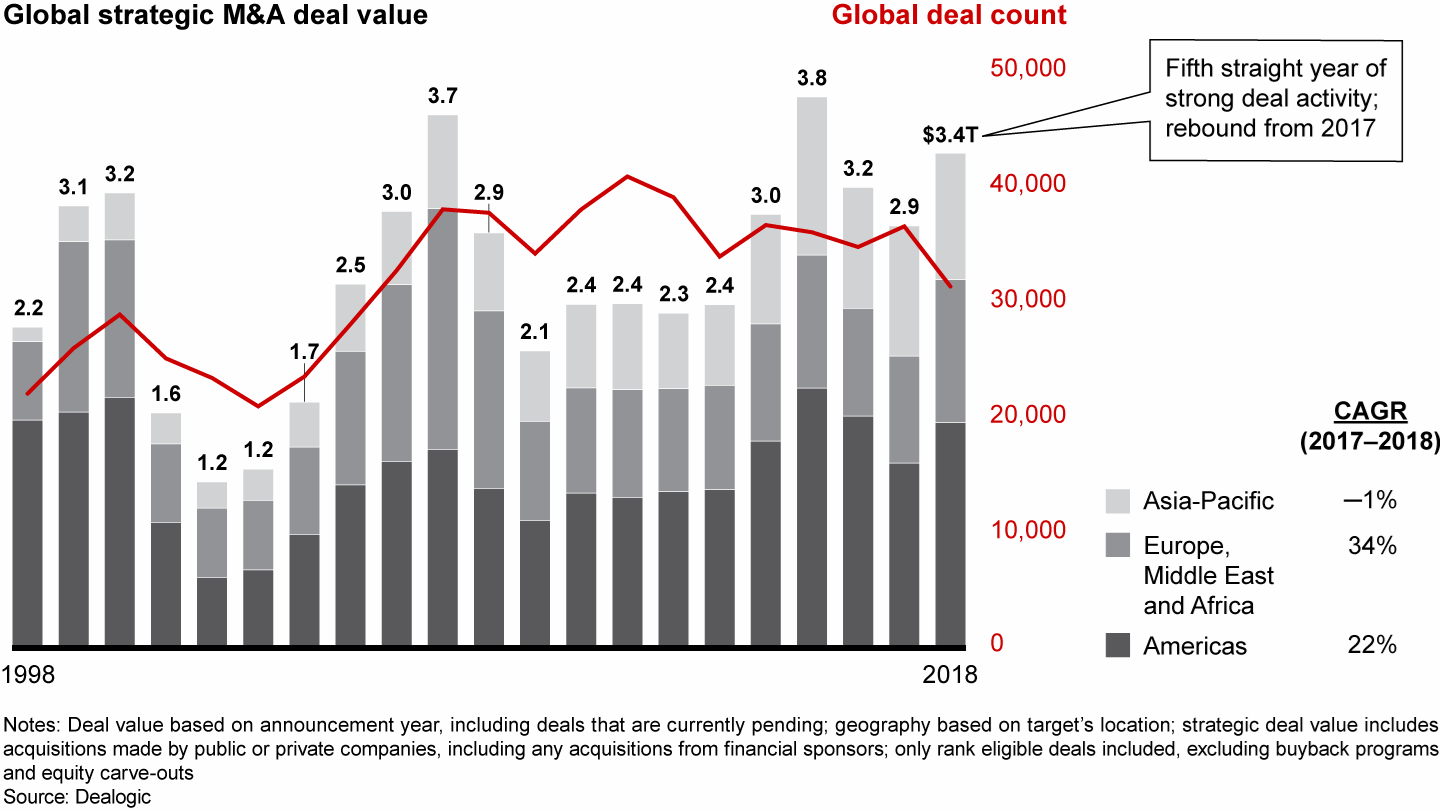
Let’s look quickly at a few deals that defined the essence of the year.
We saw digitally native companies, such as Alibaba and Amazon, buying other digital companies to expand their internal capabilities. Ele.me, a food delivery platform, allows Alibaba to expand in food and other delivery services in China. PillPack gives Amazon a foothold in the online pharmacy space. All of this is done with an eye toward further disrupting industry incumbents.
At the same time, industry leaders in nondigital businesses, such as Medtronic and Richemont, secured businesses that gave them capabilities to do old things in new ways. Medtronic bought Mazor Robotics to gain access to its robotic guidance systems to assist human surgeons performing spinal surgery. Richemont, which owns an impressive roster of luxury brands, secured the capability to go directly to its consumers with the acquisition of YOOX Net-A-Porter, an e-commerce platform.
Not all M&A that involves disruption was necessarily digitally based. Comcast bought Sky, the UK-based satellite TV and broadband platform, as part of a continuing consolidation of content and distribution in the media world. And Mars, the confectionary and pet food company, entered the veterinarian services business in Europe through the acquisitions of AniCura and Linnaeus.
The unifying theme of all these deals? They are scope transactions, designed to enhance capabilities and open up new markets (think of scope vs. scale as adjacencies vs. synergies). The challenges associated with making scope deals successful are large, and they’re different than the challenges of more traditional scale deals. In section 3, we discuss how to make scope deals successful.
Bain Partner Les Baird discusses why acquirers need new capabilities to succeed as the number of scope deals surpasses scale deals.
While digital disruption is front and center of many executives’ concerns in 2018, most industries were already grappling with an existing wave of disruption.
- Consumer products are seeing a rise of insurgent brands (young companies selling the next big thing) and declining benefits of scale.
- The healthcare industry feels increased regulatory pressure and scrutiny to lower costs.
- Industrial companies are reacting to reduced cost arbitrage and demand for greater agility by rethinking their supply chains.
- Financial services companies are coping with profitability pressures in a more complex regulatory environment.
- In retail, low-cost business models are redefining consumer value.
The stress of all this disruption is putting pressure on companies to grow or face an existential crisis. The difficulty of sustainably growing the business is the biggest strategic challenge that many of our clients face. In response, executives are turning to scope deals to find growth in new areas. As we shall see, sometimes this growth will come from being more digitally savvy, and sometimes this growth will come from entering new markets or geographies.
Disruption amid sustained growth challenges
Indeed, the revenue growth trend for most publicly listed companies has been down over the past decade. While 2018 shows a bit of a reprieve, low-single-digit growth has become the new normal for many companies (see Figure 1.2).
Revenue growth rates are lower than historic levels

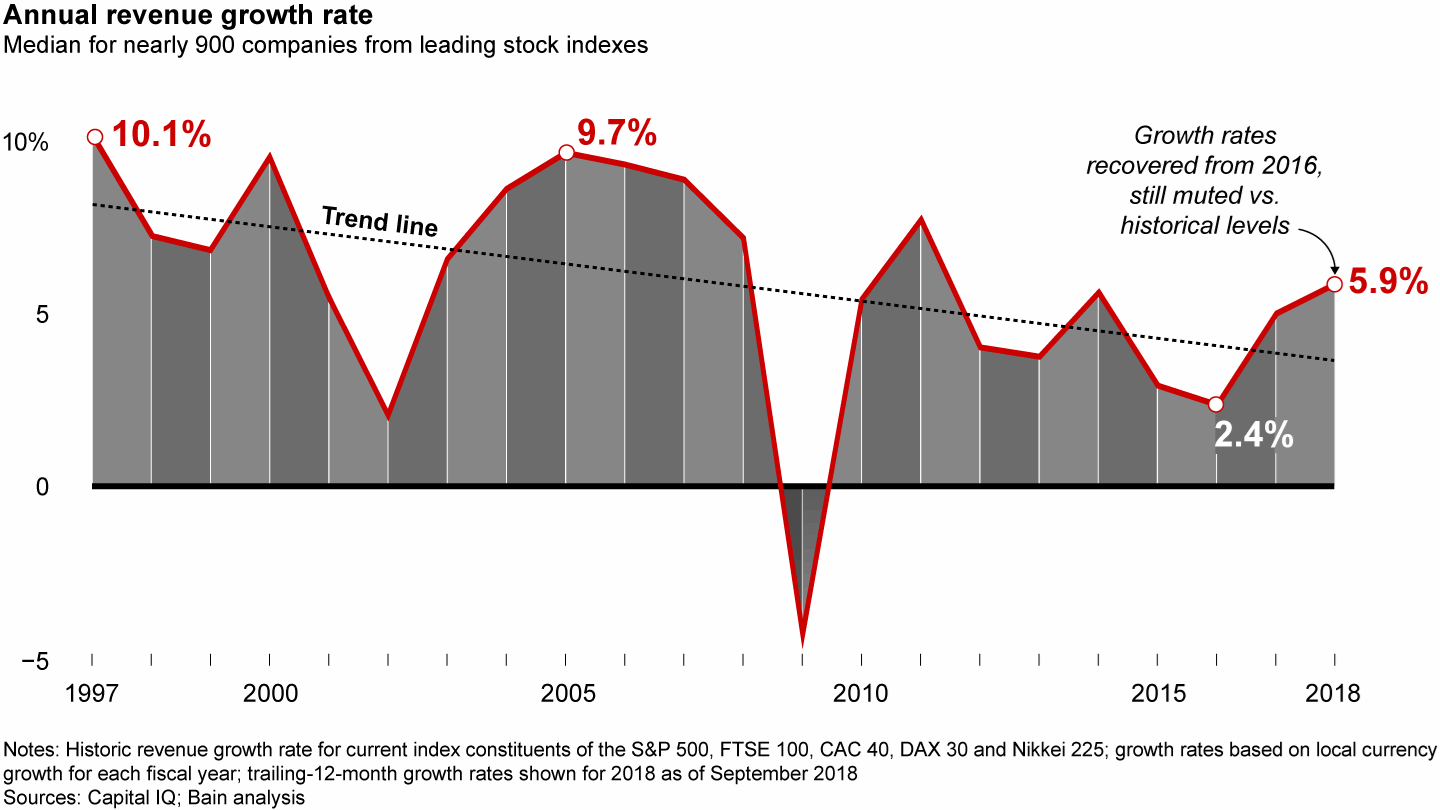
There are a number of reasons to believe that the 2018 uptick in growth is an aberration caused by factors such as the stimulating effect of changes to US tax law. More enduring is the sustained downturn in research and development (R&D) and capital expenditure (see Figure 1.3). Over the past five years, leading companies from key developed markets have actually reduced the proportion of discretionary cash reinvested for organic growth.
Decrease in discretionary cash spent on organic growth drivers, R&D and capital expenditure

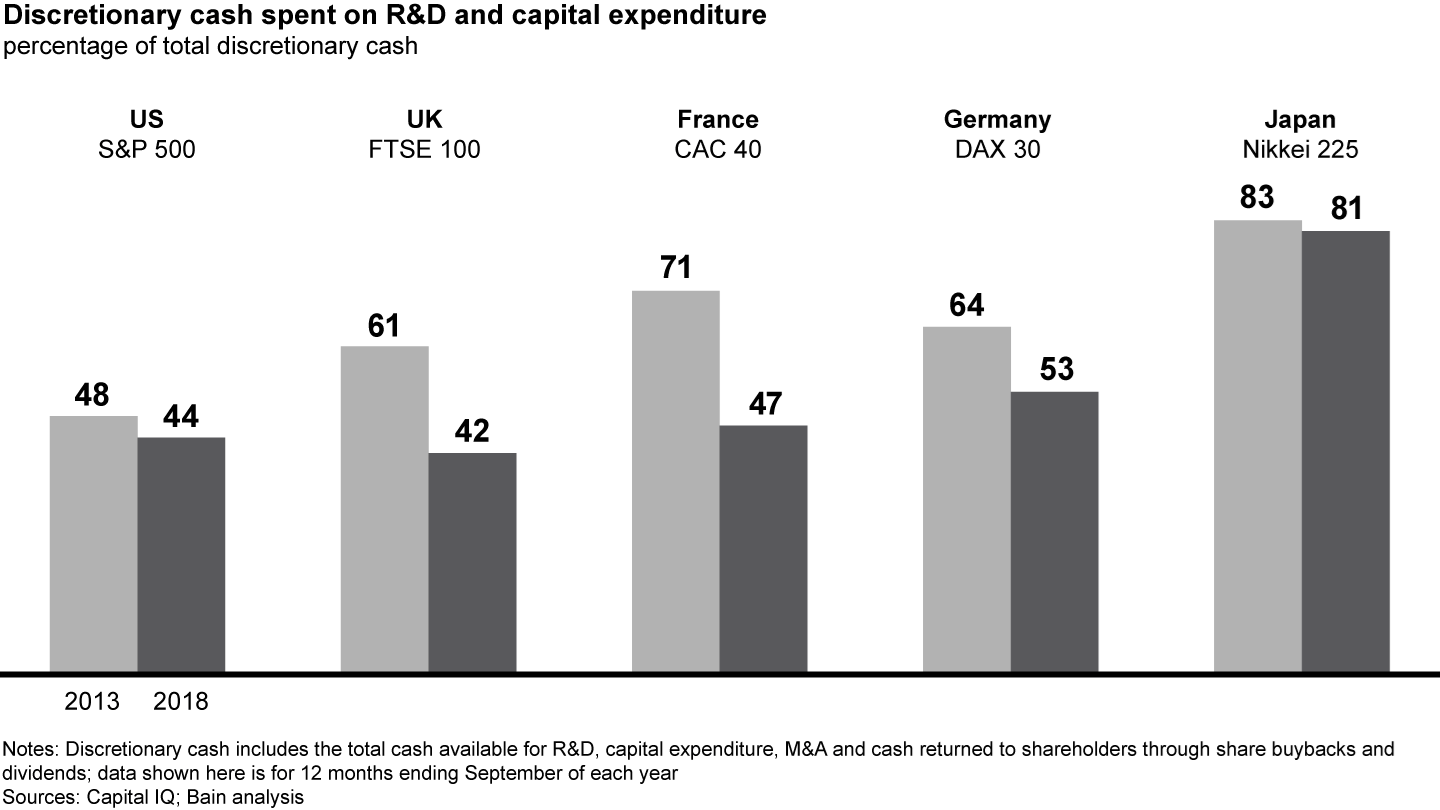
Executives debate the wisdom of returning cash to shareholders now vs. reinvesting in the business. In any capital allocation decision, price and value must always be considered. And we acknowledge that there can be times when the intrinsic value of a firm far exceeds market value and share repurchases make tremendous sense. We see many executives, however, feeling pressure to buy back stock rather than invest for the long term. Total shareholder return (TSR) is getting short shrift during the current buyback frenzy.
Observation 1: Over periods longer than five years, the highest TSR comes from consistently growing operating cash flows, not from financial engineering.
Observation 2: Companies that grow faster than their peers generally trade at 20% to 50% multiple premiums in their industry (see Figure 1.4). Growth is good for long-term stock multiples, and we might add that a strong stock multiple increases the flexibility to do more M&A.
Observation 3: The markets like growth, and it does not matter if that growth comes from organic business operations or through a well-managed acquisition machine. Investors reward the capability to sustainably add new businesses and growth.
High-valuation multiple premium for growth leaders

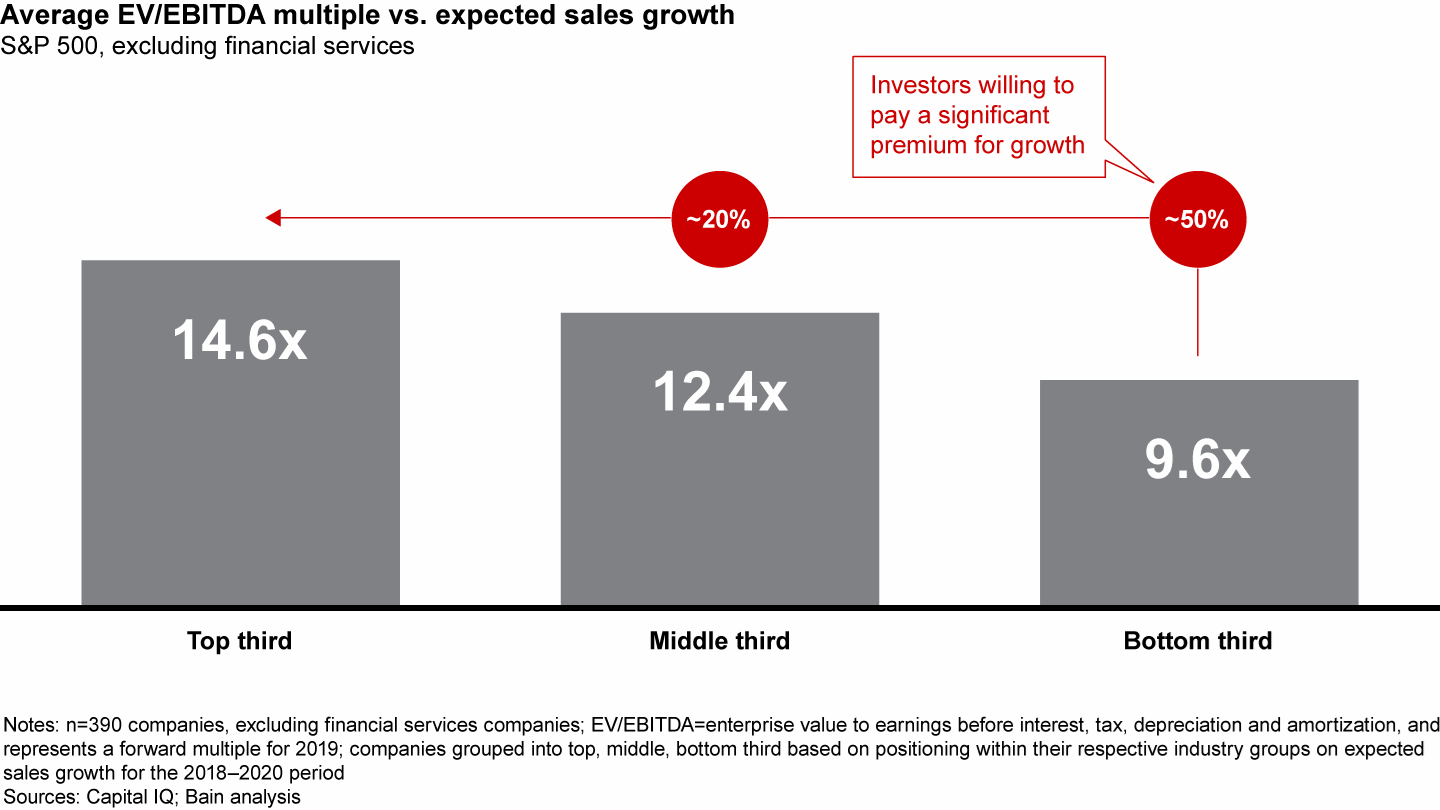
The twin imperatives to grow while riding the wave of disruption is resulting in a new era of M&A. To capitalize on these new realities, executives are increasingly turning to scope deals, particularly capability-led scope deals.
Disruption and growth challenges are the headlines of 2018, but there was a lot more happening. In the next section, we look at the five most important M&A trends of the year.
Section 2: Key M&A trends of 2018
In section 1, we described a year of industry disruption, strong M&A and struggling growth engines. Given that backdrop, we see five important trends that are changing the M&A landscape.
- M&A moves beyond scale—scope M&A accelerates.
- Financial sponsors behave like strategics.
- Activists play the M&A card to great effect.
- Governments intervene on grounds of national interest.
- Cross-regional deal making loses momentum.
These five trends will shape how M&A evolves over the next few years, but they are not all equal. We start with the shift from scale to scope deals. This is the most profound trend of 2018, with implications for all executives and all elements of the M&A model.
Beyond scale—scope M&A accelerates
At a Glance
- The challenges of industry disruption and slower growth, combined with existing levels of consolidation and government intervention, have led to an increase in scope deals—they outnumbered scale deals for the first time in 2018.
- Scope deals to acquire new capabilities have accelerated dramatically over the past three years and now represent 15% of all strategic deals.
- Today, these capability deals have two different motives: product or service innovation, often digital; and cross-sector acquisitions to transform and redefine the combined business.
- The majority of capability building is the result of smaller bets in new technologies and business models. Corporate venture capital, which has emerged as a key route to smaller capability investments, increased four times over the past five years.
Scope deals are more prominent now and outnumbered scale deals in 2018
Some of the largest deals that hit the headlines over the past couple of years were not intended to just make companies bigger or generate cost synergies.
To see this in action, let’s look again at some of the prominent deals announced in 2018. In the healthcare industry: Amazon bought PillPack, an online pharmacy; Roche bought Flatiron, a software provider for oncology-specific electronic health records; Medtronic bought Mazor Robotics, a manufacturer of a robotic guidance system for spinal surgery; and Cigna bought Express Scripts, a pharmacy benefits manager.
In consumer products: Keurig Green Mountain merged with Dr Pepper Snapple to form Keurig Dr Pepper; Coca-Cola acquired Costa Coffee; General Mills acquired Blue Buffalo Pet Products; and Mars acquired two veterinary chains in Europe, AniCura and Linnaeus. Prominent technology acquisitions included Alibaba’s purchase of online food delivery provider Ele.me; IBM’s acquisition of open source software company Red Hat; Microsoft’s acquisition of GitHub, a web-based hosting service for version control, mainly for computer code; and Salesforce.com’s acquisition of MuleSoft, a software provider for connecting applications, data and devices.
The media industry saw Comcast’s bid for Sky, a UK-based TV satellite and broadband company. In financial services, AXA acquired XL Group, a global property and casualty commercial line insurer and reinsurer. The retail industry saw Walmart’s acquisition of Flipkart, India’s leading online retailer; and Richemont’s acquisition of YOOX Net-A-Porter, an online retailer of luxury goods.
These deals represent different industries, but they share an important characteristic. They are not the traditional scale deals aimed at building market power and generating synergies; they are scope deals to enter faster-growing product or service segments or geographies, or to acquire capabilities to turbocharge future growth.
Bain Partner Peter Horsley discusses why acquirers should focus on three crucial areas—diligence, operating model and integration—to improve performance and gain a competitive edge.
As a reminder, let’s recap how we define the deal types. Scale deals are intended to strengthen market leadership and lower cost position through the benefits of scale (namely, cost synergies). Scope deals are intended to accelerate top-line growth by adding attractive market segments or new capabilities. In reality, some deals are a blend of both scale and scope, but the vast majority lean toward one or the other.
Within scope deals, the most familiar type is aimed at enhancing an acquirer’s near-term growth profile by buying companies with faster-growing products, services or geographies. A second type of scope deal is designed to give an acquirer access to a capability. Traditionally, these have been value chain deals involving forward or backward integration moves. They were intended to reinforce a competitive advantage, such as access to a source of raw materials. In the face of today’s business model disruption, however, we also see companies pursue capability deals for other reasons. Some capability acquisitions are aimed at delivering product or service innovation, often digital. Some are cross-sector deals to transform and redefine the combined business.
Overall, scope deals outnumbered scale deals for the first time in 2018 (see Figure 2.1). We believe that this rapid rise of scope deals in response to industry disruption and growth challenges may be the biggest M&A industry development over the past decade. This shift brings with it tremendous implications for companies.
Increase in scope-oriented deal making over the past three years

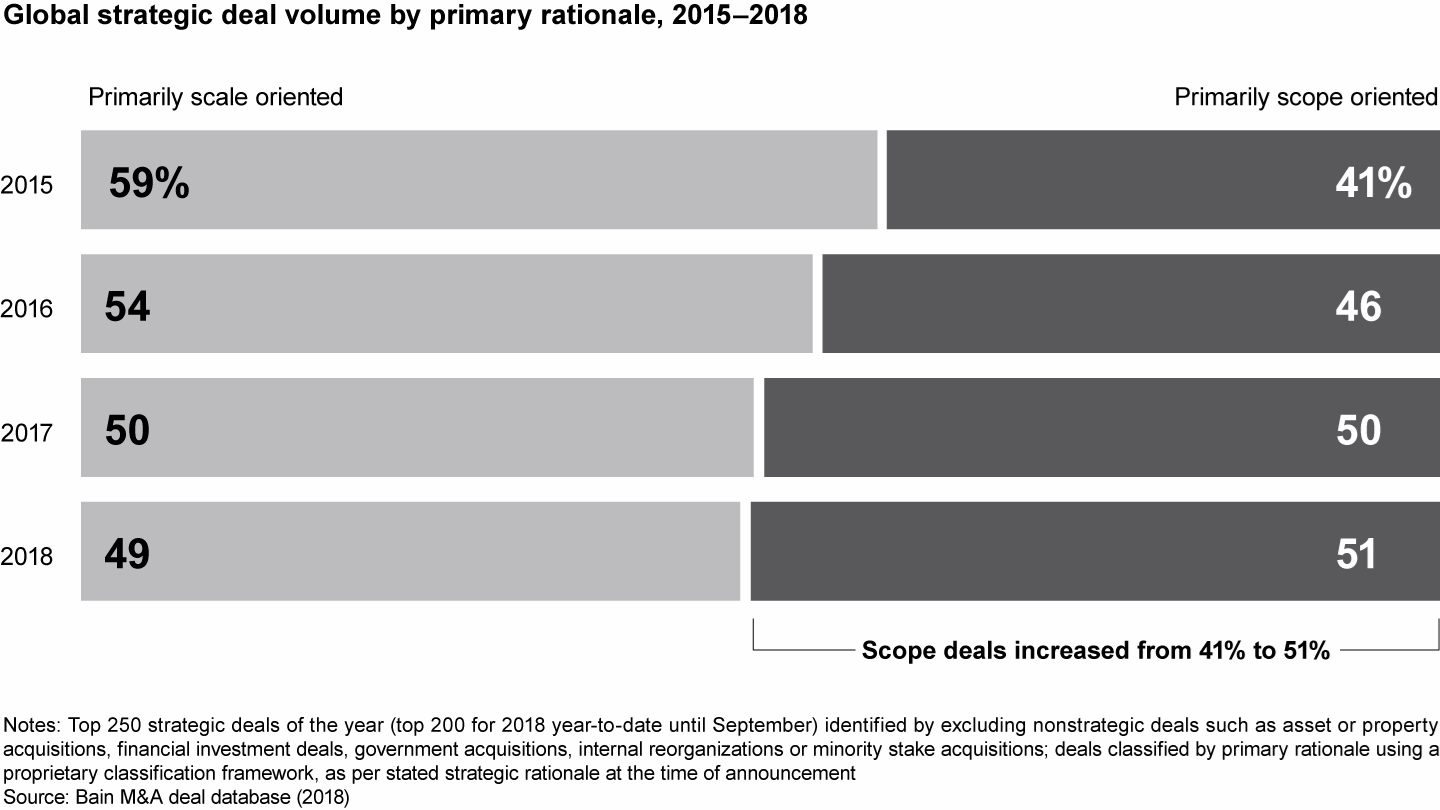
We expect the trend to continue, largely because more and more executives are relying on M&A to solve their historic “do I build it, or do I buy it?” dilemma when it comes to investing in growth initiatives and capability building.
While scope deals continue to grow, we likely will still see further rounds of scale deals as incumbents push for market scale in declining or stalling businesses to create the funding for future growth.
Scope deals to gain new capabilities accelerated over the past three years
Of the two types of scope deals, the most dramatic growth has been in those aimed at acquiring new capabilities. Capability M&A has increased to represent roughly 15% of all strategic deals valued at more than $1 billion in 2018, compared with 2% in 2015 (see Figure 2.2). We expect this trend to be even stronger at the smaller end of the deal spectrum, where the majority of capability deals are made.
Deals to acquire new capabilities have increased dramatically

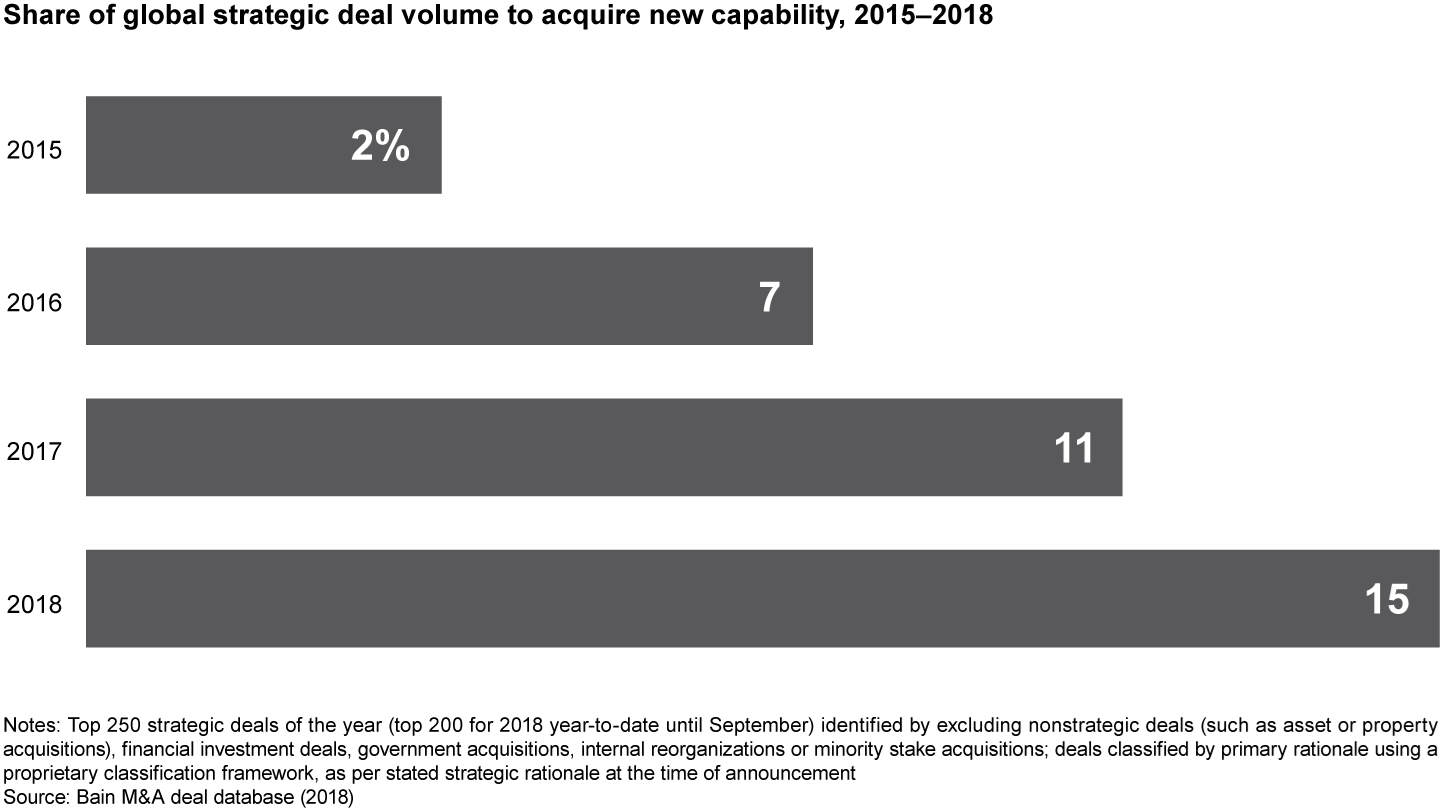
As we discussed earlier, historically, capability deals were mainly value chain deals. Now, there are new motives: product or service innovation, often digital, and cross-sector deals to transform and redefine the combined business.
Taking a closer look at the first motive, almost one-third of capability deals involved the outright acquisition of a capability to target digital opportunities, such as autonomous cars, e-commerce, the Internet of Things, digital manufacturing, digital security, digital content/marketing/advertising and digital healthcare. It is not only technology stalwarts that are buying these capabilities but also companies from other industries that are experiencing fast digital disruption (and opportunities): automotive, consumer products, healthcare, retail, media, telecom and even utilities—and we know this list is growing.
The valuations underlying some of these digital capability acquisitions are sometimes staggering as these assets often involve must-have digital capabilities (see Figure 2.3).
Staggering deal multiples for digital capability acquisitions

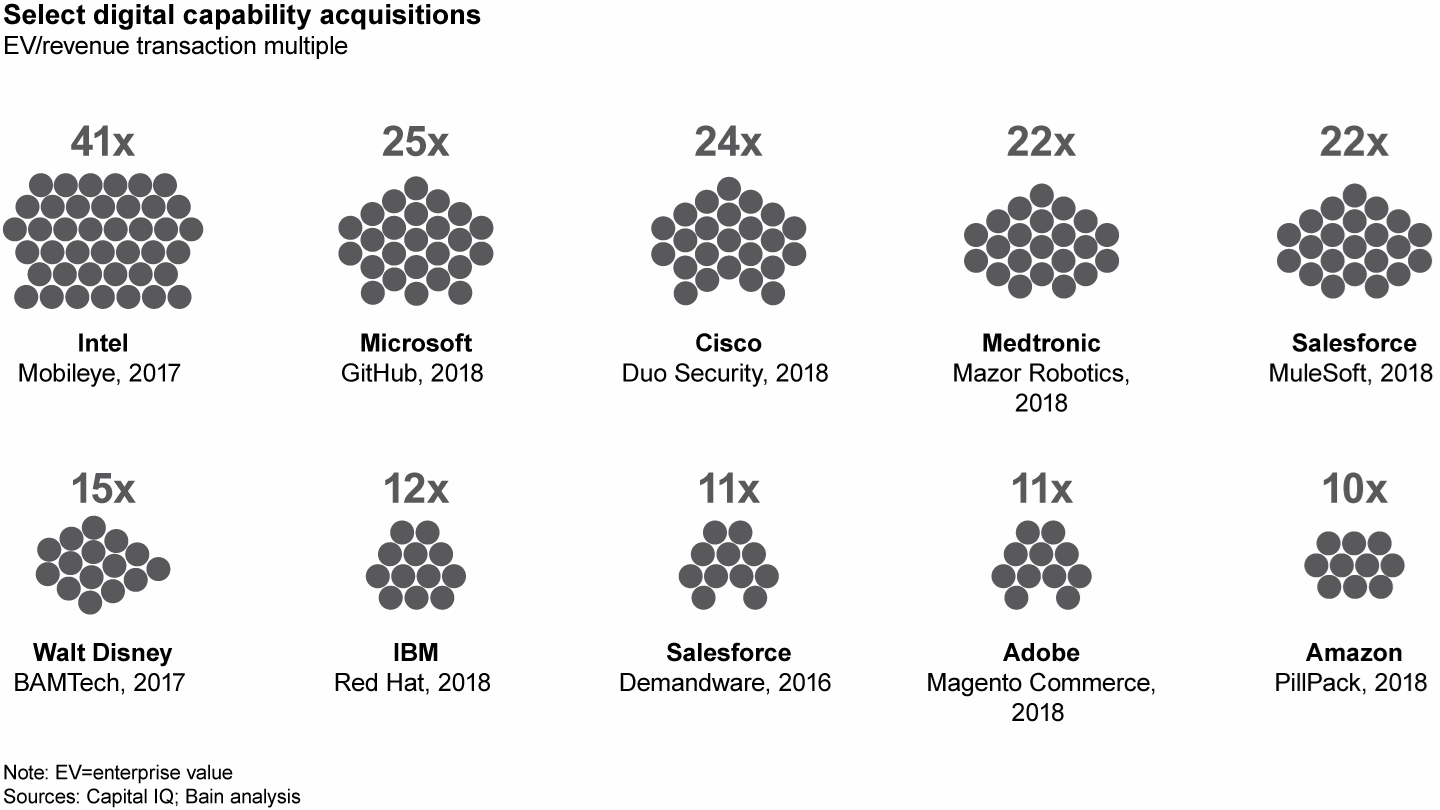
While large capability deals make the headlines, the reality is that most have been smaller acquisitions that fill specific capability gaps. As an example, let’s consider the automotive industry in light of changing industry dynamics due to the rise of on-demand ride-hailing services, electric cars and the race to launch autonomous vehicles.
Volkswagen has made a series of capability deals and partnerships in these growth areas. It invested in GETT, a transportation-on-demand provider; partnered with Mobvoi for Chinese natural language processing using artificial intelligence technologies; and teamed with QuantumScape to secure access to solid-state battery technology. These capability investments happen outside of the company’s traditional core. As such, they require an assessment of new business models and often another collaboration model, such as joint ventures and partnerships, rather than outright acquisition. These arrangements are not new. As early as 2015, Audi, BMW and Daimler (parent of Mercedes-Benz) formed a joint venture to acquire Nokia’s HERE digital mapping and location services business, with an eye toward the capabilities required for autonomous vehicles.
The second motive for capability deals: Transform or redefine a company through cross-sector acquisitions. Some of the combinations we see today would not have entered a company’s consideration set even a couple of years ago.
This scenario has played out prominently in US healthcare, where several disruptive forces are at play, including the impending entry of Amazon, rising regulatory pressure to lower healthcare costs and technological advances in health records. Healthcare has seen a flurry of deal activity breaking down existing industry boundaries in a bid to lower costs and improve transparency between providers and consumers. Consider M&A announcements by leading insurers, pharmacy benefits managers and pharmacy chains in the US—namely, Cigna and Express Scripts, CVS Health and Aetna, and UnitedHealth’s Optum business and DaVita Medical Group (part of DaVita), among others. Zooming in on UnitedHealth, a health insurance major, the company has been making cross-sector scope acquisitions in direct-to-patient businesses, including medical care and pharmacy benefits management, through its Optum medical services business. Optum’s announced acquisition of DaVita Medical Group, comprising nearly 300 medical clinics, is part of this broader move. All of this activity is a response to the disruption playing out across the US healthcare industry.
Corporate venturing is another route for smaller bets on capabilities
As we mentioned, the majority of capability building takes place through smaller deals, partnerships and joint ventures. Corporate venture capital is increasing in popularity as a route for making smaller bets in emerging technologies and business models. Since 2013, corporate venture capital invested has increased by more than four times, with investments in all things digital leading the charge (see Figure 2.4).
Corporate venture capital investing increased by more than four times over the past five years

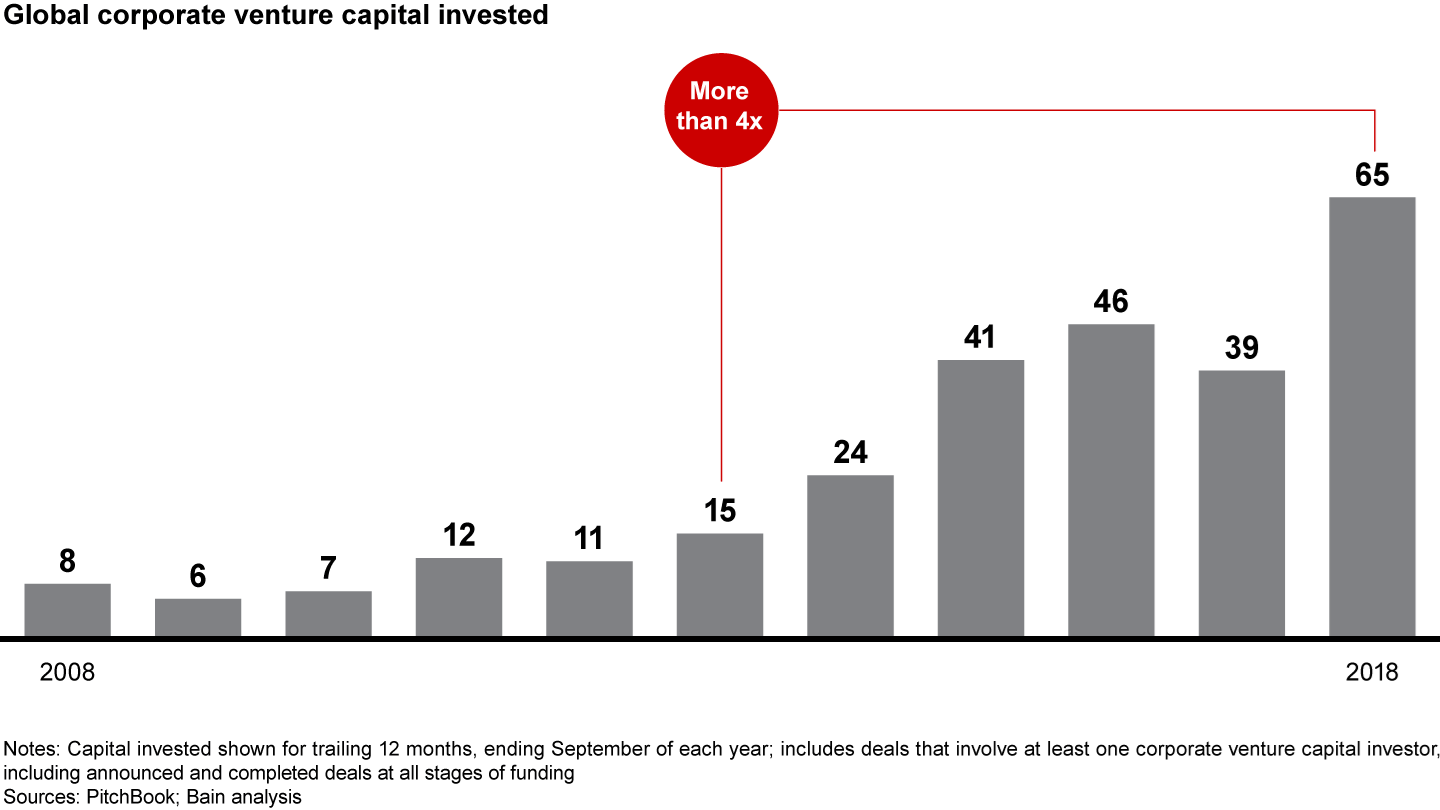
Much of the corporate venture capital investment is done in the technology industry, but there has been strong investment momentum in advanced manufacturing, financial services and consumer products. These industries have seen multifold increases in corporate venture capital investments since 2013 (see Figure 2.5).
Corporate venture capital investing trends stronger in some sectors

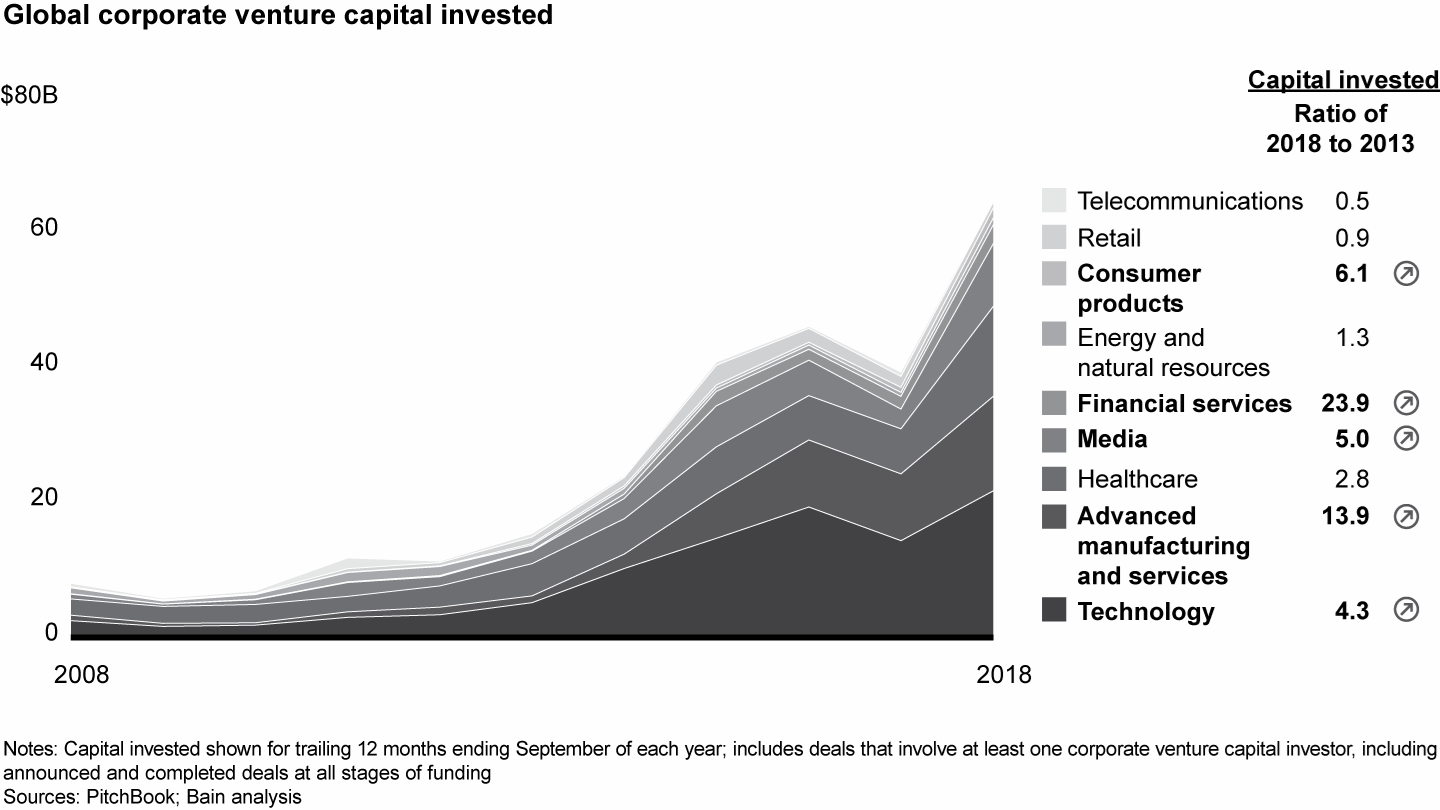
Corporate venture capital investing is justified on the basis of giving companies exposure to new ways of doing things that are too costly, time consuming or difficult to build internally. In many cases, these investments involve almost no physical assets, but contain a fair amount of intellectual property supported by personnel that represent the Silicon Valley ethos—that is, young, disruptive, irreverent and mission focused. Needless to say, venture capital investing does not play to the strengths of many established corporates, often requiring partnerships with their more experienced traditional venture capital counterparts.
Financial sponsors behave like strategics
At a Glance
- Financial sponsors, such as private equity firms, evolve their game and start to behave more like strategic investors.
- Despite this, strategic buyers continue to represent roughly 83% of all M&A deal value and gained share in 2018.
- Given this competitive backdrop, strategics need to include sponsors in their industry M&A game board and prepare accordingly.
- This includes thinking about how to use sponsors as a source of liquidity for noncore assets.
Sponsors raise their game to behave a lot more like strategic investors
Sponsors, mostly private equity (PE) firms, always get a good share of the press. The number of PE buyout firms hunting for deals has risen steadily each year for a decade and now totals more than 1,200. They are more active and hold record levels of dry powder, with $641 billion earmarked for buyouts as of October 2018. Collectively, sponsors cannot seem to find enough good investments to put all this capital and expertise to work. In our work with clients, we see sponsors turn up more and more in large deals competing with the traditional corporate buyers.
In their search for good investments, we have seen some sponsors using a wider range of approaches to invest in larger deals for longer and play the role of industry consolidator. We illustrate four of those below. When viewed collectively, these approaches make some sponsors look more like strategics.
Platform deals and add-on deals: Some sponsors now play the role of industry consolidator, buying platform assets and add-on deals to create scale. These help to turn a collection of smaller companies acquired at lesser multiples into a large enterprise with a premium valuation. These sponsors are competing harder for key platform assets, baking in future value creation in the up-front price of the initial asset. While add-on entries made up around one-third of all sponsor deals a decade ago, they comprise slightly less than half of the total today. Some of the prominent add-on deals of 2018 include Kohlberg Kravis Roberts–owned Calsonic Kansei’s acquisition of Magneti Marelli, Fiat’s automobile parts and accessories business, for around $7 billion. Another large transaction was Apollo Global Management–owned RegionalCare Hospital Partners’ acquisition of LifePoint for $5.6 billion.
Long-life funds: Platform plays and the subsequent integration often take time to pay back. This can be inconsistent with a typical PE holding period of five years. We now see several large PE firms, including CVC Capital Partners, Carlyle and Blackstone, launching buyout funds with longer lives. In 2018, KKR raised $8.5 billion for its Core Investment strategy fund, with an expected holding period of 15 years or more. In 2017, Blackstone raised $5 billion for a fund with expected holding periods roughly double those of the traditional buyout fund. Two first-time funds that year, Core Equity and Cove Hill, also raised more than $1 billion each in short order, with anticipated holding periods of up to 15 years.
Megafunds leading to megadeals: Historically, the midcap area has been the focus for many PE firms. Larger transactions were impractical given fund size and investor appetite, but this may be changing. Very large funds are on the rise, allowing involvement in megadeals. Think Carlyle’s purchase of AkzoNobel’s specialty chemicals division for $12 billion. At the end of 2017, more than 92 buyout funds with $3 billion or more were scouring the market for deals. Truly massive funds, such as Carlyle Partners’ $18.5 billion Fund VII, closed in 2018.
Partnerships: In a similar vein, we now see partnerships and creative deal structures enabling bigger deals and shared risks. Typically, these deal structures enable access to funding while addressing fundamental governance issues. An example is the Blackstone-led purchase of a majority stake in Thomson Reuters’ financial and risk unit for $20 billion. While the majority of the funding came from lead bidder Blackstone, partners Canada Pension Plan Investment Board and Singapore state fund GIC helped to spread the risk.
Despite this, strategics continue to hold roughly 83% share of global M&A deal value
Make no mistake, the vast majority of M&A, about 83% by value and approximately 90% by volume, is still done by strategics (see Figure 2.6). Strategic acquirers have maintained their volume share over the decade, even as value share fluctuates year to year. In 2018, strategics gained marginal share from sponsors.
Strategic deals gained share over sponsor deals in 2018, even as sponsor add-on deal activity stayed strong

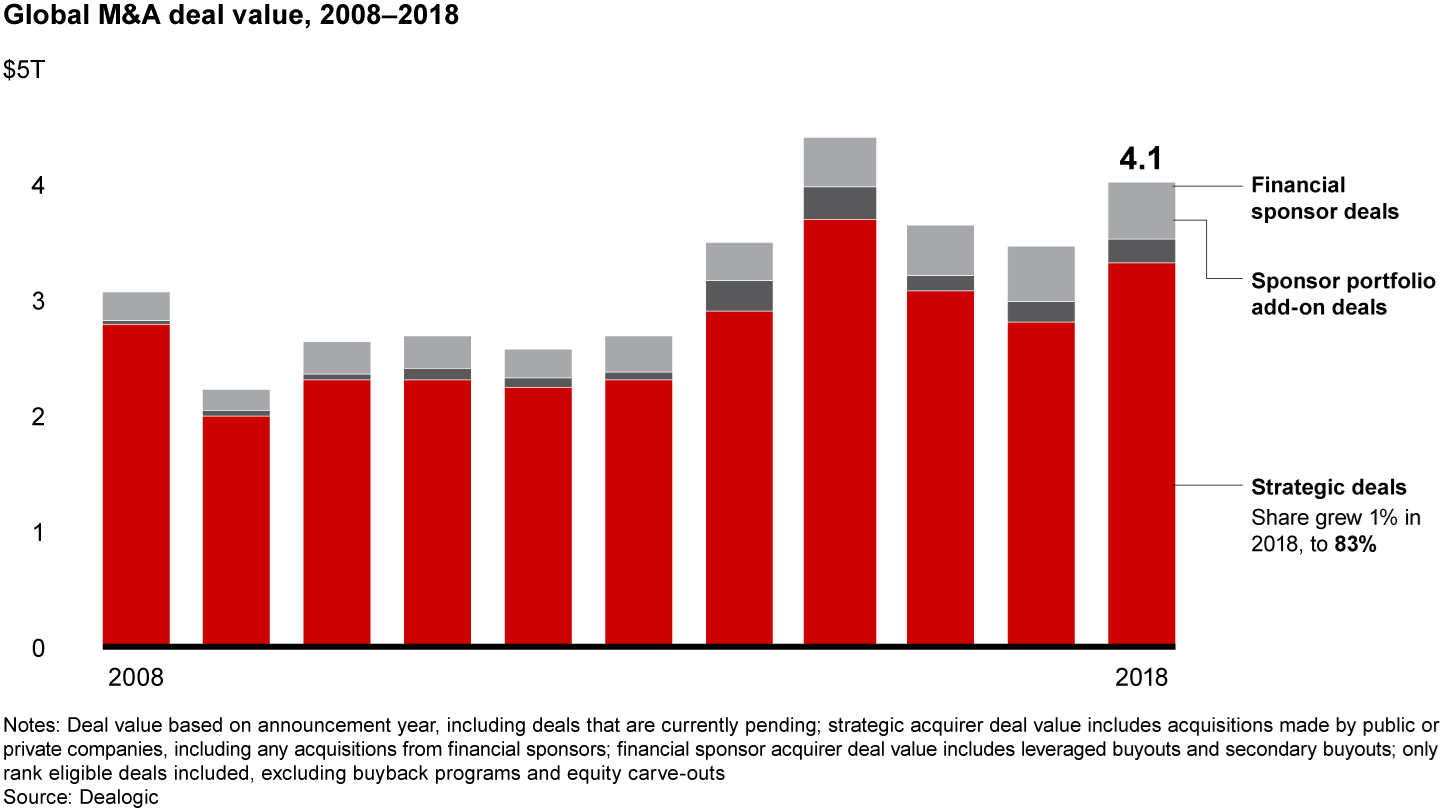
This is not true in every sector. In 2018, we saw stronger competition from sponsors in financial services and retail, where they gained share. Meanwhile strategics gained share in consumer products, healthcare, manufacturing and natural resources (see Figure 2.7).
Sponsors gained share in tech, media and telecom, financial services, and retail, but they lost share to strategics in other sectors

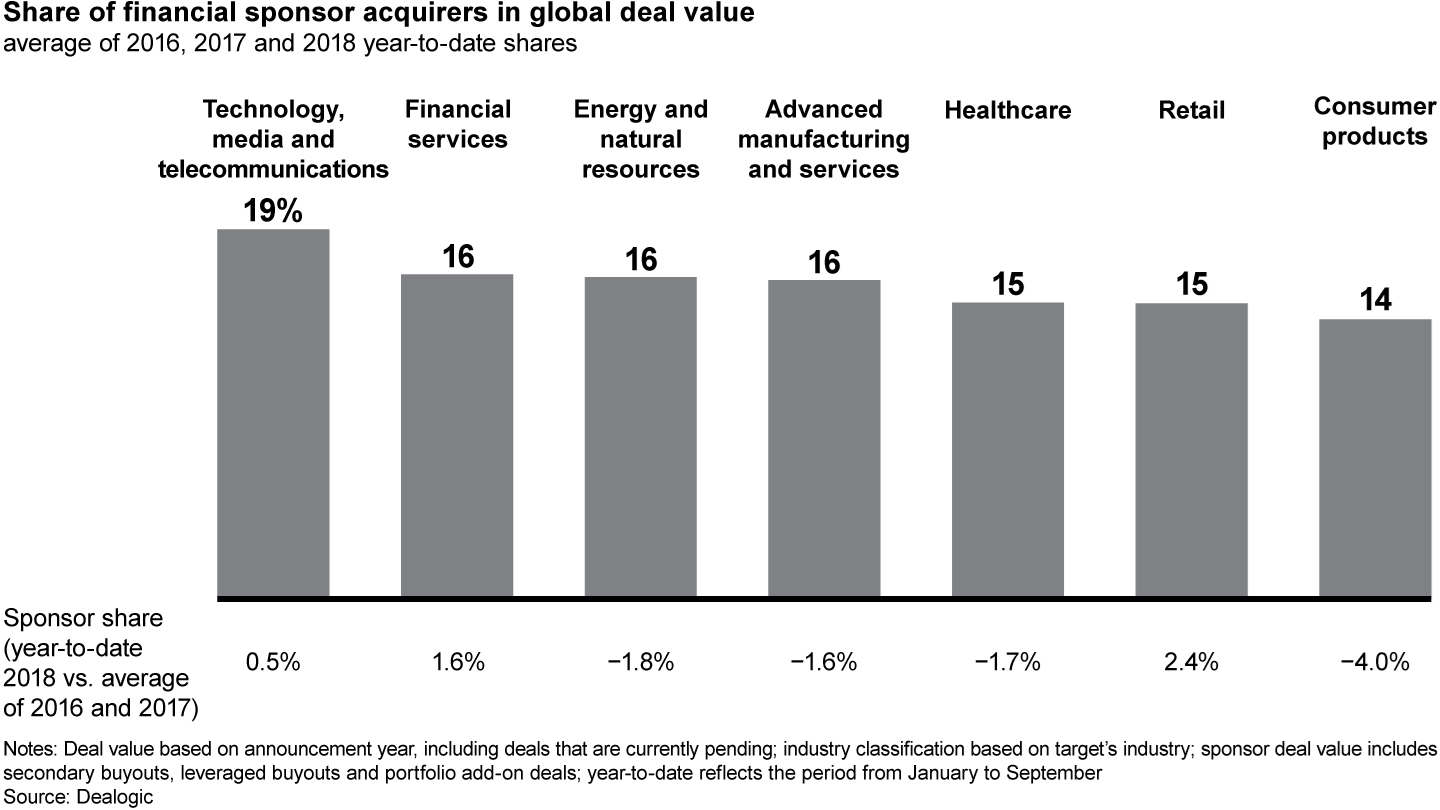
Strategics need to include sponsors in their industry M&A game board and prepare accordingly
Strategics are taking the threat posed by sponsors seriously. Historically, strategics have held the advantage in scale deals: The proprietary cost synergies gave them a valuation advantage. Now, the emergence of sponsor platforms is leveling the playing field a bit. Also, in many scope deals, strategics have limited opportunity to benefit from proprietary cost synergies. This can all feel threatening to corporates and the established industry dynamics.
Great assets are scarce, the process is competitive, and prices are high. Given this backdrop, there is an even higher premium to being prepared. This means having a view of the industry game board that includes sponsors, creating target lists, proactively reaching out to targets and developing a proprietary view on value creation from the combination of businesses. Only by sufficiently preparing can companies get ahead of industry disruption and move quickly when targets come on the market. This clarity of direction and speed to action can help strategics stay one step ahead of their sponsor competitors. We’ve included two examples of high-performing, serial corporate acquirers at the end of this report to illustrate their approach to the M&A process. (See ”What mountain climbers do differently” for more on how Anheuser-Busch InBev and Thermo Fisher Scientific approach M&A to get ahead of the competition rapidly for the most critical deals.)
We also see other strategics borrowing a tactic from the PE playbook. They comb through the portfolios of funds, looking for promising companies that might be coming up for sale. The analysis is fairly straightforward: Given the five-year investment time frame preferred by most buyout firms, strategics can scour active portfolios for companies with specific characteristics that have been held for at least three years. Isolating a short list of promising candidates allows firms to get a jump on due diligence. The objective is to be smarter and better prepared than other bidders when the asset comes up for auction.
Sponsors offer a great source of liquidity to strategics for noncore assets
Sponsors remain a good potential option for noncore businesses that strategics want to exit. The presence of sponsors can provide more liquidity and help offload businesses that would otherwise be hard to exit. Many industry leaders have used this liquidity to clean up portfolios and generate capital for growth investments.
To cite an example, Unilever was a recent beneficiary of this liquidity enabled by private equity. When it announced its intention to divest its spreads (margarine and butter) business back in 2017, there were limited prospects of finding eager corporate buyers, but a number of PE firms showed interest and competed in multiple rounds. This ultimately concluded with an approximate $8 billion sale to global investment firm KKR in one of the biggest leveraged buyouts of the year. Conspicuous was the absence of strategics bidding for the asset.
For Unilever, this was a valuable exit from a noncore business. It sent a strong signal to the investor community of its intent to transform its portfolio. For its part, KKR plans to turn around the spreads business growth trajectory and improve cash generation.
In a few recent carve-outs, strategics have stayed on as minority owners. In this role, they provide the industry knowledge and operational expertise needed for the divested asset to grow. As an example, Post Holdings formed a joint venture with Thomas H. Lee Partners, a PE firm, for joint ownership of Post’s private label foods subsidiary. After evaluating exit options, a 60/40 joint venture was arranged. Post retained a 60.5% stake, gained immediate cash inflow ($875 million) and kept the option to push for full separation in due course—all while continuing to use its industry expertise to help the private label foods business to grow.
Likewise, when Walmart wanted to exit its challenged business in Brazil, it ended up selling 80% to Advent International, a financial sponsor. In doing so, Walmart removed a big distraction from its portfolio. Yet by keeping a 20% financial stake, it maintained optionality and provided the business with ongoing access to the right retail expertise. (For more about divestitures, see the Bain Brief “Everybody Wins in Divestitures.”)
Activists play the M&A card to great effect
At a Glance
- More than 800 companies were targeted by activists between January and October 2018. More than 20% of these campaigns were explicitly based on an M&A thesis.
- Activists continue to focus on the US, but they also have large campaigns in Europe and Asia.
- With greater focus on portfolios, activists made more demands for selling or spinning off business divisions in 2018.
- Activist support for M&A/takeover of targets remained strong.
Activists are pushing for more M&A
Activist investors, such as Carl Icahn, TCI, Elliott Management, Third Point Capital, Starboard Value and Jana Partners, targeted a number of companies across the globe, demanding that management teams execute a range of M&A moves. All told, activists aimed their attention at more than 800 companies globally in 2018, including Dell, Whitbread, Sky, Danone, Hyundai, Thyssenkrupp, Olympus, Micro Focus and Teva.
Activists are demanding more M&A (see Figure 2.8). This is largely because M&A-related activism consistently produces the highest returns of any form of activist argument (for instance, corporate governance, executive compensation, business strategy or others). As Carl Icahn noted on CNBC, “I do think that the model, the activist model, is still one of the best models there is. We’ve practiced it for 18 years, and I’m proud to say that our annualized return, if you bought out a stock IEP 18 years ago when we got into this activism thing, you made a return of 15% annualized.” Many of Carl Icahn’s campaigns have been related to M&A.
Activist investments involving an M&A-related thesis now account for one in every five campaigns. In 2018, US-based activists targeted approximately 120 companies with an M&A-related thesis. M&A-related activism is international: Companies based in Europe and Asia are the targets of roughly 35% of all M&A-related activist campaigns.
M&A-related shareholder activism continues to be strong

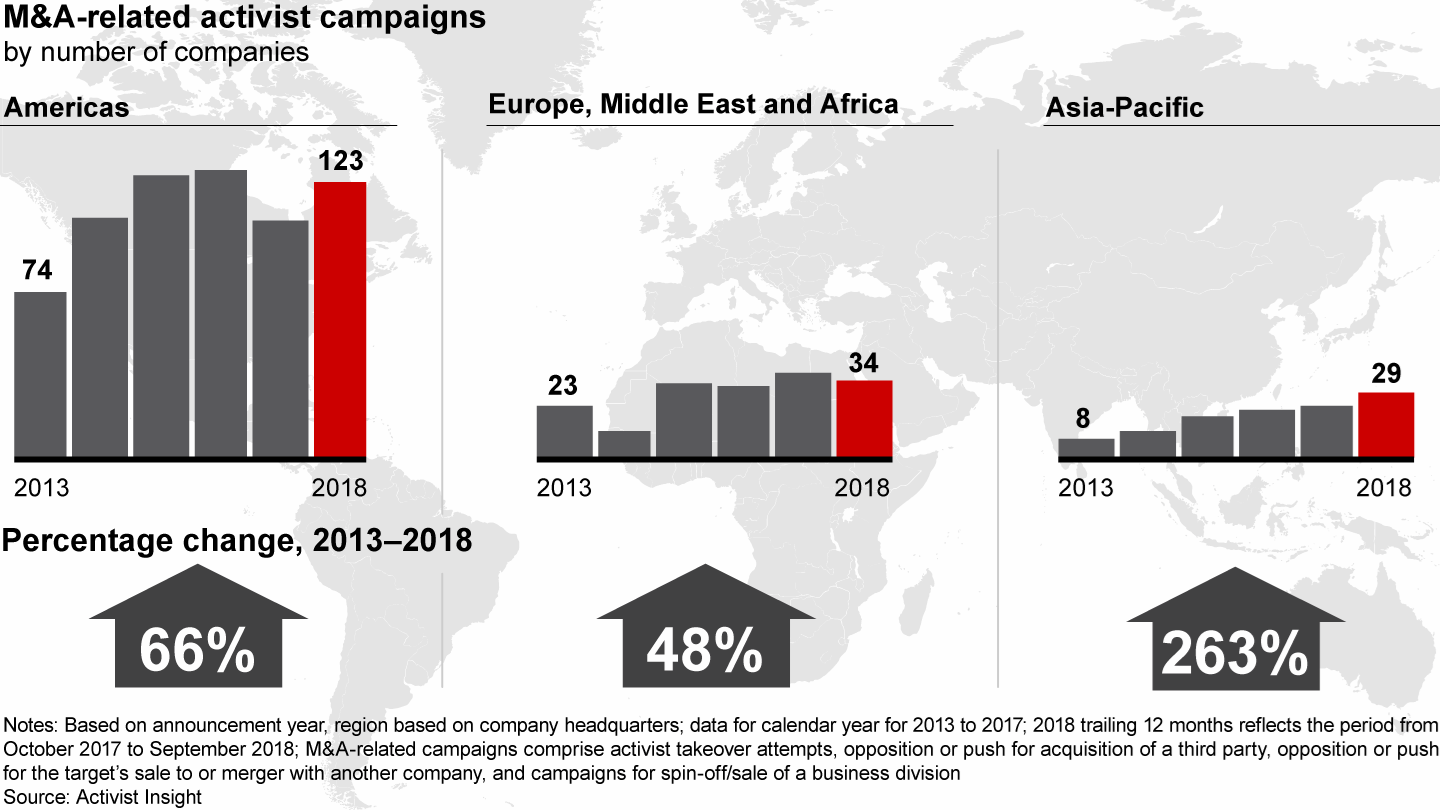
Greater activist push for sale of target and divestitures
While pushing for companies to be sold in whole or in part has been the bread and butter of much activism in the past, this approach accelerated over the past year, with some high-profile engagements. During the last 12 months, the number of campaigns calling for spin-off or sale of a business division have increased substantially (see Figure 2.9). Most prominent have been the activist campaigns at large industrial conglomerates, such as General Electric, Honeywell, Siemens and Ericsson, and at large consumer product companies, such as Nestlé, Procter & Gamble and Campbell Soup.
The number of campaigns calling for M&A or outright sale of the target increased to 91 over the past 12 months. An example of this was Blackwell Capital’s engagement with Supervalu, a US grocery wholesale and retail company. Supervalu was sold to United Natural Foods, delivering a successful outcome for the investor.
2018 saw an increase in activism for portfolio changes or outright sale to a third party

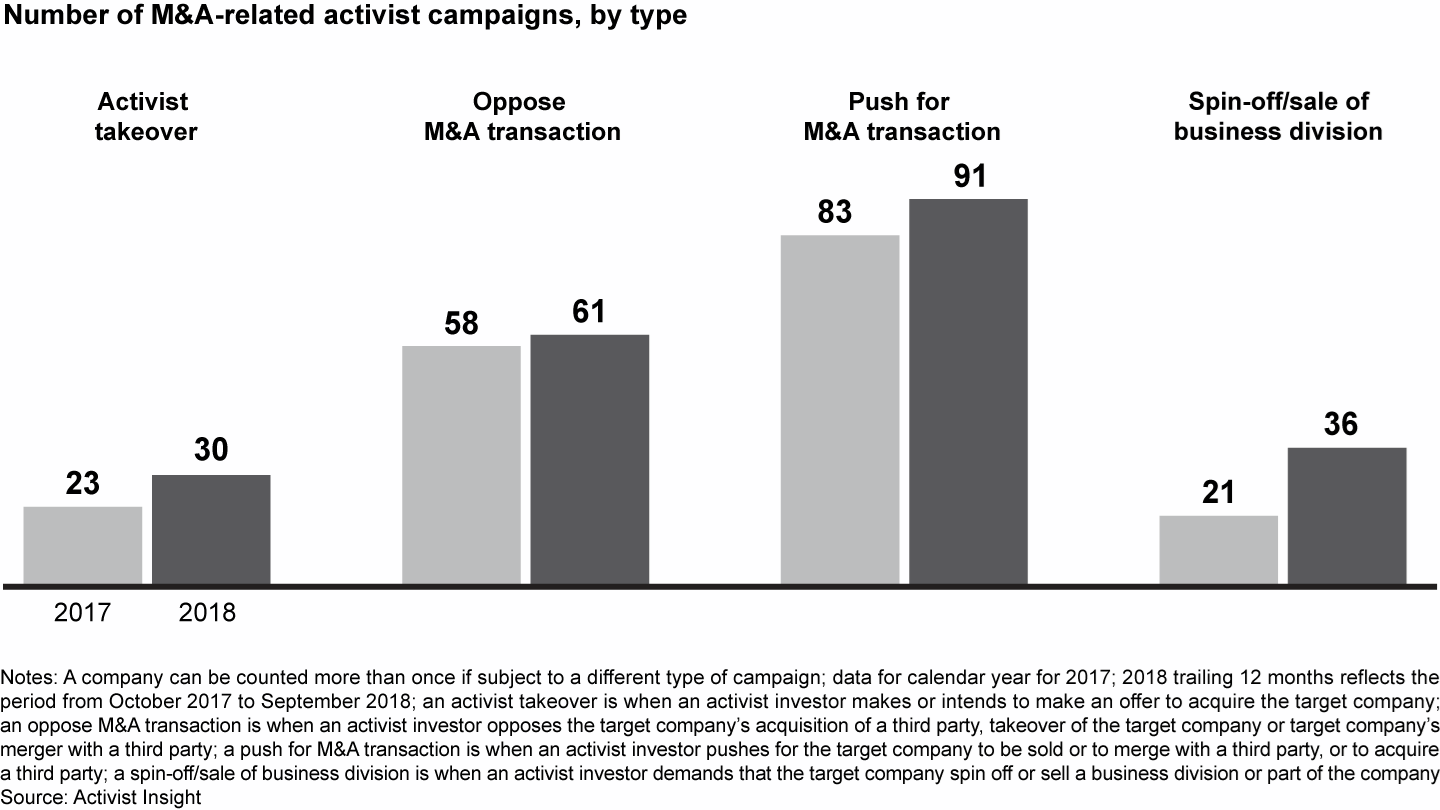
There were also several high-profile situations in which the activist intervened to stop announced deals, including Carl Icahn with Cigna-Express Scripts, which was unsuccessful. He also successfully stalled the Xerox-Fujifilm merger and attempted to block Dell’s effort to return to the public markets via an IPO. Moreover, a proposed merger between Albertsons and Rite Aid was scuttled due to shareholder pressure led by Highfields Capital Management. A US activist shareholder group that included Keith Meister’s Corvex hedge fund halted the proposed $20 billion formation of a specialty chemicals conglomerate by combining Clariant and Huntsman.
Most companies either directly or indirectly felt the impact of rising activism in their industries, which raises the bar on the up-front strategic thinking required on proposed deals, the strategic path forward and the preparation needed to be ready for shareholder engagement.
Governments intervene on grounds of national interest
At a Glance
- Troubled high-profile deals in 2018 signal a new rise in government intervention.
- Governments around the world increasingly are challenging attempts at large cross-regional business combinations on grounds of national interest and security.
- Despite the rising scrutiny, 91% of all announced deals still end up closing.
- Executives, however, will need to respond with more proactive planning for remedies and regulator engagement.
Greater power to scrutinize cross-border deals
More countries have increased their government’s power to veto transactions that they deem to be against national interest. The growing list includes the US, UK, Australia, Canada, France, Italy, Spain and Germany. A number of measures were prompted by concerns over China’s ambition to gain access to high-tech assets through M&A, although the end result is greater power to challenge cross-border deals in general.
In 2018, the US passed a law that expands the powers of the Committee on Foreign Investment in the US (CFIUS), the organization that vets foreign investments to determine if they pose a risk to national security. The enabling legislation passed the US House by a count of 400–2. The committee considers how potential transactions might affect personal data and cybersecurity, and whether an investment gives foreigners access to material nonpublic information. It also enables the US to review other types of overseas deals, such as those involving joint ventures.
In the UK, proposals tabled in 2018 imply that cross-border acquirers will face increased government scrutiny if their deals are considered to pose national security concerns. This even applies to small targets, including the acquisition of assets, intellectual property or shareholding. The threshold for intervention was lowered from £70 million to £1 million in the two areas of advanced technology and the “dual use and military use sector,” with a proposal to do away with the threshold entirely for an expanded set of sectors. As a result, the number of interventions on grounds of national security will likely increase in the UK.
Germany already expanded the government’s powers to block a non-EU-based company from acquiring more than 25% of a German entity across a wide range of sectors on grounds of national interest and security. It also expanded the powers to scrutinize who is truly the acquirer in question.
High-profile deals in 2018 signal increased scrutiny of more deals
Stakeholders across industries and around the world kept close watch on one of the most controversial cross-border deals of 2018. Singapore’s Broadcom made an unsolicited $117 billion offer for US-based semiconductor and technology equipment manufacturer Qualcomm, which was awaiting final approval from China’s Ministry of Commerce on a pending deal with Netherlands-based NXP. In the end, government decisions killed both deals.
President Trump signed an executive order that made Broadcom revoke its offer, citing the importance of Qualcomm to America’s technology infrastructure and its role as the US government’s preferred partner. Four months later, amid growing US-China trade tensions, the Qualcomm-NXP deal was halted after failing to receive approval from China’s Ministry of Commerce, which noted alleged price fixing as the main reason for its decision.
As both a potential buyer and seller, Qualcomm found itself the victim of a rising trend: Government authorities now are taking a much closer look at deals that involve sensitive technological capabilities and data.
Cross-border deals will still close but with greater preparation
On average, 91% of all announced strategic deals closed over the past 10 years. This does not appear to be changing.
Yet, the time, expense and remedies to get these deals approved is only going to increase. Increased regulatory intervention raises the bar on due diligence and the depth of preparation needed for regulator engagement. It also puts a premium on having a solid deal thesis that can help guide remedy preparation and avoid losing value in that process.
Cross-regional deal making loses momentum
At a Glance
- 2018 was a mixed year for cross-regional deal making. Despite an increase in deal value over 2017, deal volumes have continued to decline from the peaks of 2015 and 2016.
- The combination of geopolitical uncertainty and declining structural arbitrage opportunities has increased the risk and reduced the upside of cross-border deals.
- The single biggest change is the maturing of China outbound deal making to focus on winning at home as well as exporting abroad.
Cross-regional deals have lost momentum since 2016
A big story in M&A over the past 10 years was the explosion in cross-regional deal making.
Overall, 2016 marked the high point for cross-regional M&A. Deal flow cooled in 2017 and partially recovered in 2018 on the back of a few megadeals (see Figure 2.10).
In 2016, deal flows strengthened across the board—among Europe, Middle East and Africa; the Americas; as well as Asia-Pacific outbound deals spearheaded by China. Overall, cross-regional deal making almost tripled from the bottom of the financial crisis in 2009 to 2016. Most notably, Asia-Pacific outbound M&A quintupled, with especially strong momentum in 2016. Among the cross-border deals of that year: Bayer and Monsanto’s $66 billion combination, Praxair and Linde’s $50 billion deal and ChemChina’s $45 billion acquisition of Syngenta. Those were the largest outbound deals of that year from Europe, the Americas and Asia-Pacific, respectively.
Since then, things have cooled. In 2017, we saw a sharp decline in cross-regional deal value. Capital controls and greater internal scrutiny on deal financing curbed enthusiasm for outbound deals from China. European deal flow to the Americas halved.
While a few headline 2018 deals, such as Takeda’s $81 billion bid for Shire, boosted Asia-Pacific outbound M&A deal value, the reality is that total cross-border deal count dropped by approximately 20%. In fact, in terms of number of deals, the cross-regional trend has been declining since 2015.
Cross-regional deal value bounced back from 2017 levels, but deal count is flat or declining

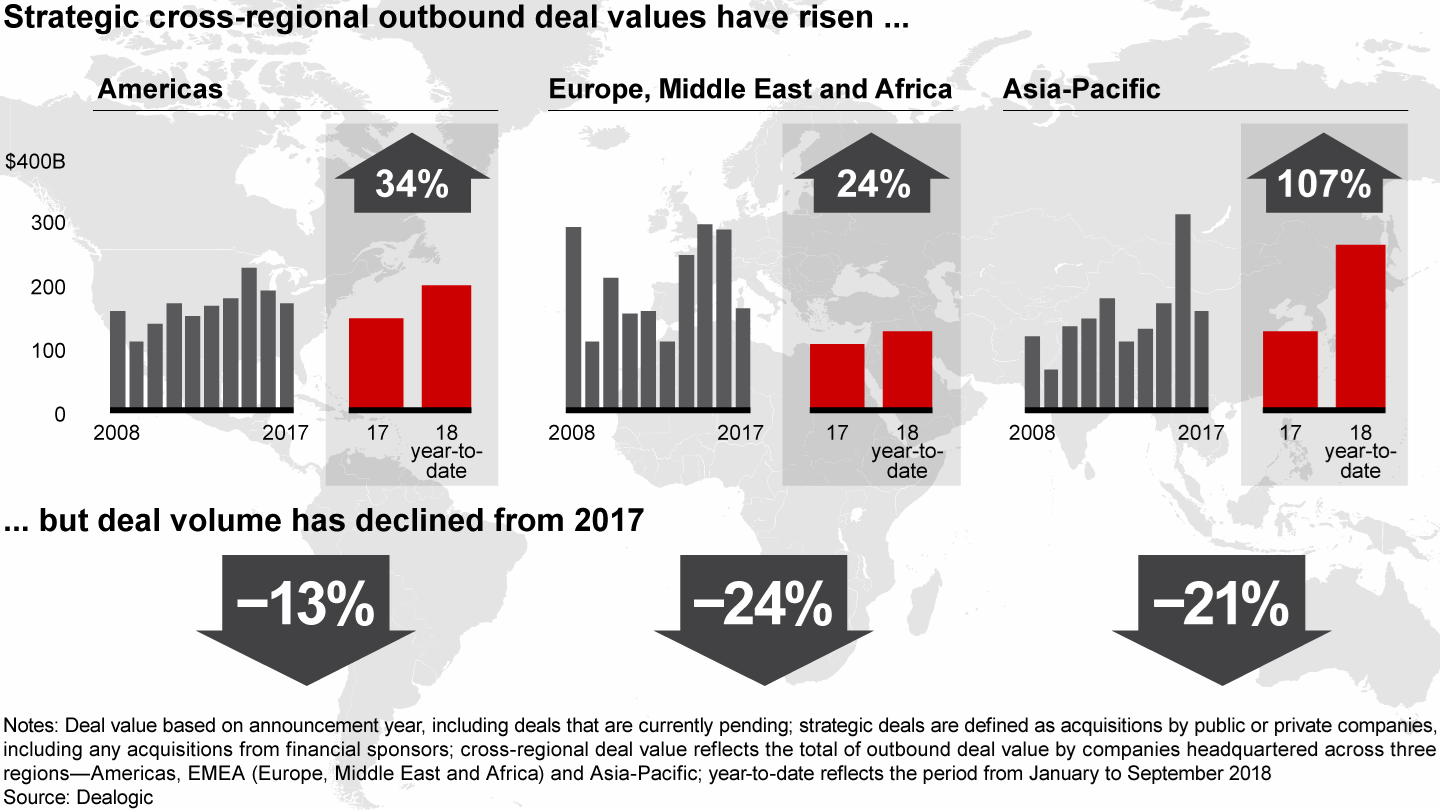
Cross-regional deals now more risky with less upside
The combination of geopolitical uncertainty and declining structural arbitrage opportunities across regions has paused cross-regional deal making. On the geopolitical front, capital controls and increased government regulation has made cross-regional deals more protracted and risky. The ongoing threat of trade tariffs has added to the uncertainty and introduced significant downside.
Over the longer term, the arbitrage opportunities across regions, such as those for labor costs, have declined substantially. Also, the wave of investments to tap into developing markets has largely played out, although industries such as consumer products are notable exceptions. And executives in Asia increasingly are targeting companies within their region. All told, cross-regional deals now are being made more on the fundamental economic merits of each deal vs. structural or national interest reasons alone.
The single biggest change since the peak in 2016 has been the reduction in China outbound M&A. Only three years ago, much of the M&A talk in China was about cross-regional deals: ChemChina and Syngenta, State Grid Corporation of China and CPFL Energia, Tencent and Supercell, HNA Group and Hilton (25% stake), among others. Now, the M&A news from China is all about deals within the region.
Nowhere has this been illustrated better than in China’s Internet space, where Alibaba and Tencent have become leading domestic consolidators. Roughly 70% to 80% of their deal making is concentrated in Asia-Pacific. Combined, they have spent at least $20 billion over 12 months (ending May 2018). The number could be much higher given that many investments are undisclosed or private deals. Both Alibaba and Tencent are valued at around $500 billion on public markets. Both act as the SoftBank or Berkshire Hathaway of the new Chinese economy, investing in hundreds of companies at all stages (see the Harvard Business Review article, “There’s Only One Way to Break into China’s Crowded Retail Market”).
Maturing of China’s cross-border M&A
Alibaba and Tencent are examples of the evolution that typically occurs as acquirers grow and learn to hone their skills from repeated deals. Chinese companies acquiring overseas are entering their third phase of evolution. During the first phase, the vast majority of outbound M&A deals were made to secure natural resources. The second wave of activity was largely about acquiring brands or technology and other capabilities that Chinese companies could use to help build their businesses at home. Now, when companies look to acquire beyond China’s borders, it is often to help them achieve the dual goals of winning at home and exporting abroad. This enables them to strengthen their domestic competitive stance while simultaneously positioning them for global expansion, often in other developing markets (see Figure 2.11).
Maturing of China outbound M&A

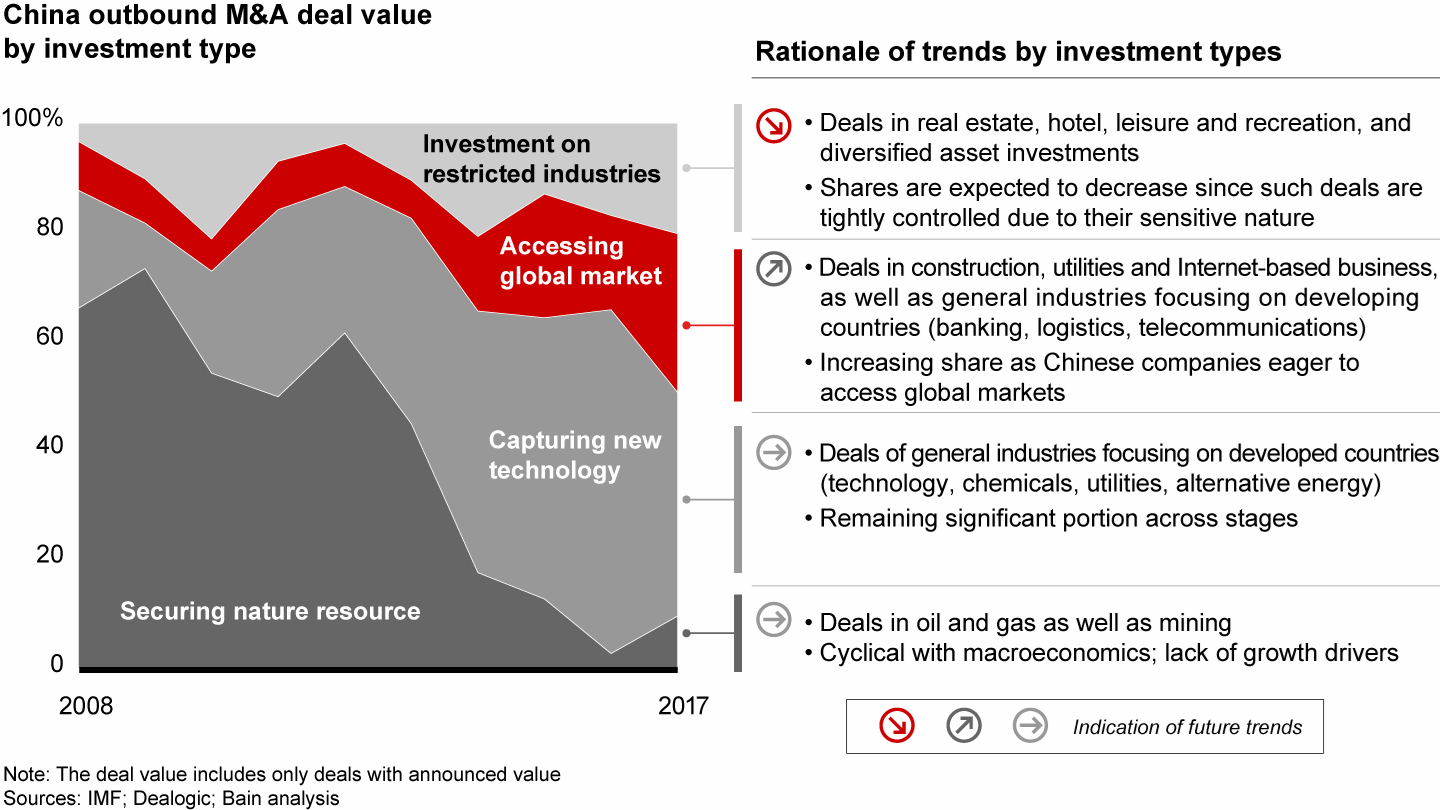
It is not just the role of M&A that is changing but also who is doing it. The number of private enterprises acquiring overseas is growing much faster than acquisitions made by state-owned enterprises. This reflects the shift away from the first phase of acquiring to secure scarce natural resources.
The evolution to using acquisitions to win both at home and overseas brings with it new and more complicated rules for success. As those rules change, an expanding group of Chinese companies are learning how to apply more rigor to their acquisitions. Shandong Ruyi Technology Group serves as a good illustration: It has developed a systematic way of accumulating M&A experience while steadily growing its business. Ruyi first targeted and bought small Japanese and Korean fashion brands, testing and learning how to bring them to China. It then targeted midrange European luxury brands, such as France’s SMCP. Once it felt comfortable with those acquisitions, it moved up to higher-level luxury brands such as Switzerland-based Bally. In all, Ruyi has invested more than $5 billion to build a strong brand portfolio in apparel.
Section 3: Implications for strategic deal makers
The trends highlighted in section 2 have profound implications for the successful management of the entire M&A value creation cycle. A world where companies are doing more scope deals than ever under more investor and regulatory scrutiny requires decision makers to rethink their approaches to deals. That means taking a fresh look at the strategic framing, diligence, integration and management of business combination activities.
At Bain we have been privileged to work on almost 1,500 M&A projects with both strategics and sponsors over the past year alone. We use this section to share our observations on what the best are doing to succeed.
Our extensive research over the past two decades has uncovered one enduring truth: A repeatable M&A capability, developed through consistent M&A activity over various economic cycles, contributes to higher shareholder returns. This finding holds up year after year, across industries. Deal success and failure is more a matter of cumulative experience and capability in doing deals, and less a function of standalone deal circumstances.
Similar to most things in life, you get better at what you do when you do it repeatedly. Companies that acquire frequently tend to outperform the average company on TSR. Companies that not only acquire frequently but also develop the capabilities to undertake larger deals representing a meaningful percentage of their market capitalization do even better. We call these companies “mountain climbers.” (For more details, please see the section on “Bain’s bedrock beliefs on how to create value from M&A.”)
The Goldilocks conditions of cheap capital, healthy cash reserves and strong equity markets will not last forever. Disruption will remain, and it will intensify. For companies turning toward M&A to help feed or fend off the disruption, the hard-learned lessons of successful deal makers will become more relevant than ever.
Building this repeatable capability for M&A, however, is not easy. In particular, the leap from scale deals to scope deals is a large one. The new wave of M&A involving capability-driven scope deals requires a fundamentally different way of thinking to realize the value.
In this section, we conduct a deep dive into this new way of thinking to help executives retool their approach to due diligence, evolve their business operating models and develop different ways to approach business processes and systems.
Due diligence—the bar is rising
At a Glance
- Insightful diligence differentiates the best acquirers.
- The best acquirers get the classic diligence principles right, as outlined in “Bain’s bedrock beliefs on how to create value from M&A.”
- And the best acquirers also do three things differently: They take a broader view at the diligence stage, creatively use new data and tools, and, most important, tailor the diligence by type of deal.
- Scope deals are different: The stakes tend to be higher, and they require a more forward-looking diligence assessment.
The bar for insightful diligence is rising
Multiple executive and deal surveys show that the vast majority of failed deals can be traced back to ineffective diligence.
The bar for insightful diligence is rising. Almost every asset that comes on the market today goes through a competitive process. This means that the winning bidder must have more confidence than anybody else about how they are going to manage and run the acquired business and extract the value. This value creation roadmap is drafted during the diligence process.
So how do you get differentiated insights? We see three new steps the best acquirers are taking.
- They analyze a broader set of factors and use cross-functional teaming.
- They use newly available digital data and tools to go beyond what they see in the data room.
- They recognize individual deal characteristics and take a differentiated approach for scope vs. scale deal diligence.
Let’s look into these approaches one by one.
Broader set of factors to consider in due diligence
The best acquirers recognize that diligence is not only about strategic or synergy assessment. Many other factors present both hidden upside and risks: operational factors, such as systems compatibility; talent and culture issues; and regulatory and legal factors, such as data privacy and public relations. Taking a broader view of diligence, however, requires more internal cross-functional teaming and bringing in external experts.
Cross-functional teaming often quickly highlights areas where deeper diligence is needed to avoid costly disruptions down the road. That includes the need to prepare up front for regulator consultations or assess systems compatibility in advance.
We’ve summarized the five broad areas to assess during diligence (see Figure 3.1). The best acquirers develop stronger conviction during diligence by diving deep into the most important catalysts for value and risks for each deal.
Increasing breadth and depth of factors in due diligence

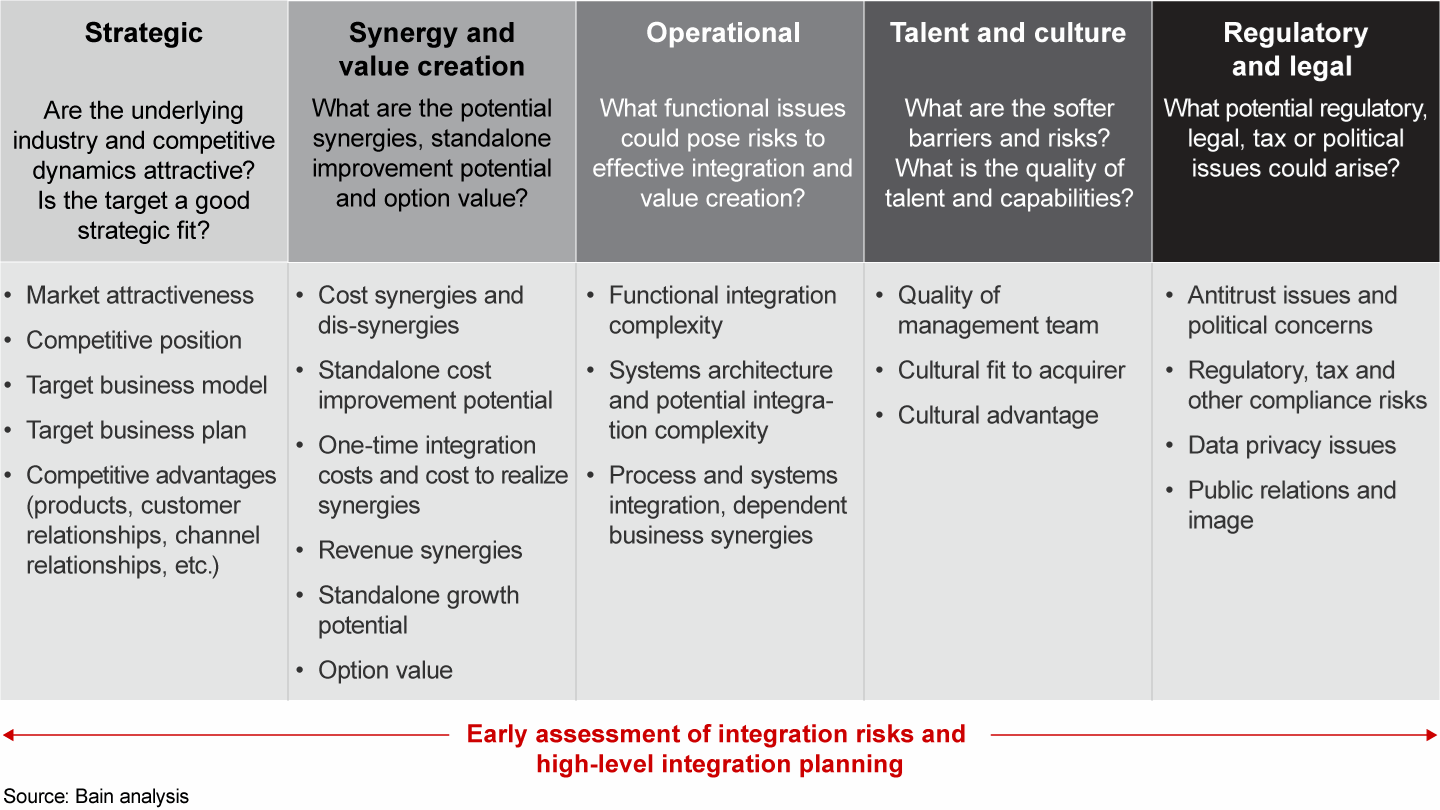
In response to these changes, we see many executives demanding more speed and agility from their diligence teams. This requires more internal capability building and fostering a company’s external network. Both of these imply doing work ahead of the moment of truth.
Digital data and tools enable diligence to go beyond the data room
Deal markets are more and more competitive. Assets are more expensive. You have to get every advantage you can to win.
Fortunately, a lot more digital data is available today in the public domain to strengthen diligence. These new information sources and tools enable more robust outside-in diligence to complement traditional diligence. In fact, an entire ecosystem of resources has sprung up to leverage this data, including experts, analytical techniques and tools. The new reality: If you are not using the new data and tools, you are behind.
Let’s consider some of the possibilities for outside-in diligence for business-to-consumer businesses.
- Digital marketing assessment: How effective are the target’s digital marketing efforts? How do they compare with competitors? What could be the potential value from improving their capabilities to more competitive levels?
- Customer purchase behavior: What does credit card purchase data suggest about the target’s ability to attract the right demographic and increase conversion and share of wallet on large marketplaces?
- Customer sentiment: What is the brand perception and nature of customer feedback on social media?
Additionally, employee review sites allow for much more robust leadership, talent and culture assessment for almost any company. The data is available in the public domain, although it still requires specialized tools for analysis.
For example, one potential acquirer performing diligence on a technology target wanted to understand employee advocacy and attrition risk. An outside-in view using an employee review site showed a weak position. Employees stay with the company for the time being, mainly due to an attractive location and a desire to benefit from the expected IPO. This flagged the need for more proactive retention planning, leadership training and culture change initiatives at the target.
One concern: The amount of publicly available data is huge and not always of consistent quality (think fake reviews). It is also expensive to use for a single diligence. Drawing the right insights requires the right vendor relationships, the ability to discern good data from bad, specialized analytics and strategic thinking.
Scope deal diligence is distinct from scale diligence
In scale combinations, the buyer intimately knows the industry and the rules of the road. There is a well-established playbook for diligence and integration. After all, the primary value creation levers are market position, cost synergies and operational efficiencies. Revenue synergies are rarely required to pencil a deal and are conservatively excluded from the deal model.
It’s different with scope deals—they carry higher deal premiums and yield much lower cost synergies (see Figure 3.2). The sources of value often come from revenue synergies and capability transfer. As a result, such deals place a higher burden of proof on the acquirer. For example, investor relations challenges are greater, and acquirers must be prepared to answer questions about their parenting advantage.
Scope deals tend to be smaller, carry higher deal premiums and lower bankable cost synergies

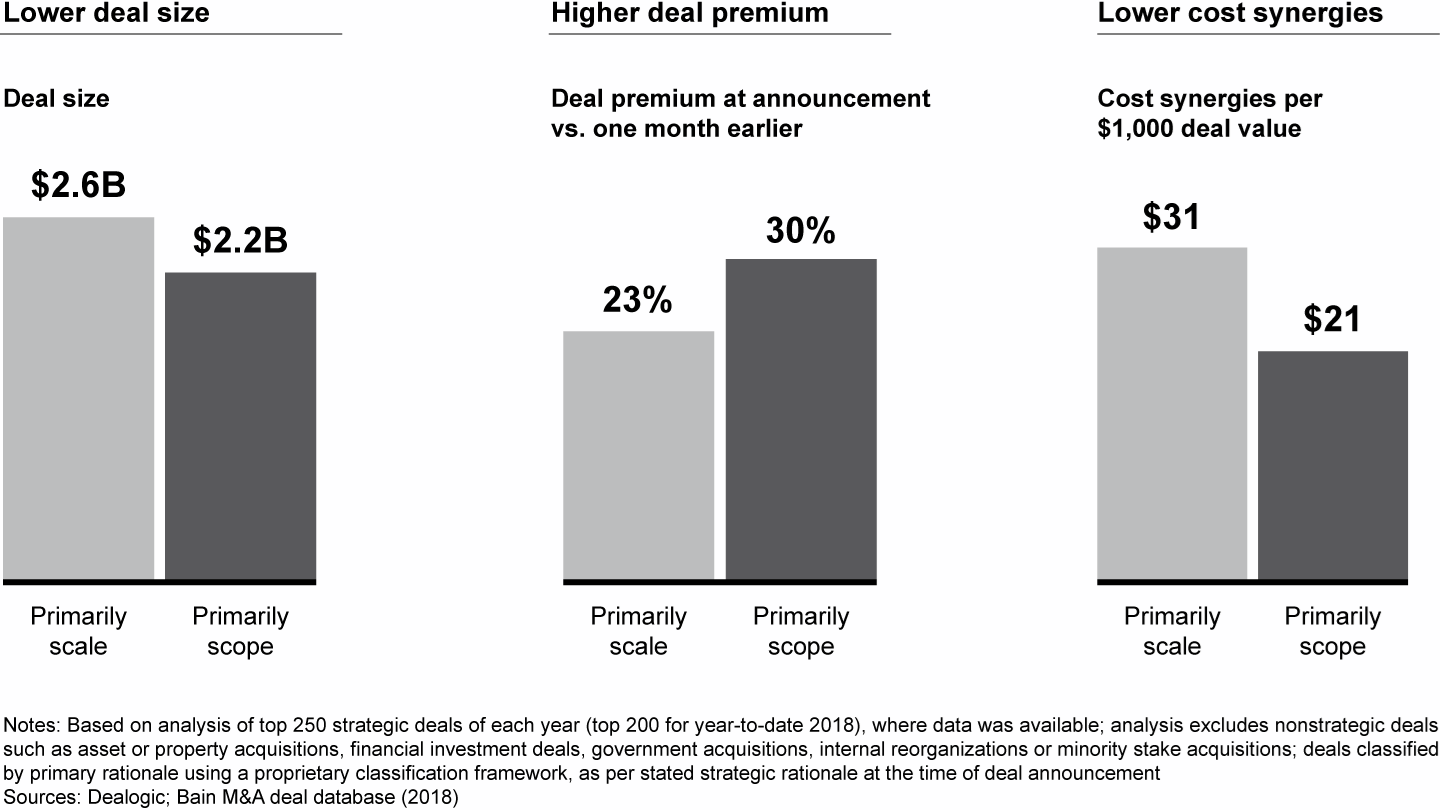
Scope deal diligence involves a much deeper dive into the target’s industry attractiveness, business model, keystone capabilities, standalone growth potential and caliber of management team. Sources of value are quite distinct from scale deals, and require more forward-looking assessments around revenue synergies and future option value.
Typical revenue synergy sources involve cross-selling opportunities, combined product development, greater go-to-market coverage, channel optimization and entirely new channel capabilities. A commitment to these key value drivers and the associated probabilities is critical for scope deals.
Digital asset diligence turns traditional diligence on its head
In digital asset acquisitions, acquirers need to develop conviction around how the business may evolve under various scenarios as opposed to analyzing past performance. The deal thesis is typically captured as “what you need to believe” about the key assumptions for future scenarios. The best companies get creative through the use of innovative data, the voice of the customer and a community of external technical experts. They also clearly understand their own parenting advantage and how they can accelerate the target’s growth.
It’s worth noting that given the forward-looking nature of these diligences, some uncertainties always remain.
Consider the diligence conducted on a ride-hailing app operating in three service segments (ride hailing, food delivery, last-mile logistics) supported by an e-payment platform. The diligence focused on two forward-looking questions: What is the full potential addressable market size for each segment? And what would it take for the target to be profitable?
The addressable market question entailed scenario building for multiple end states based on how customer adoption and usage rates may evolve. The assumptions were supported by a consumer survey, complemented by proprietary analyses of location data and online ordering data. Top-down triangulation with other ride-hailing markets provided an additional frame of reference. Assessing profitability similarly involved evaluating how the key levers—in this case, the user price and driver hourly compensation—would develop at scale. By considering overall deal economics and other synergistic benefits, the company ultimately chose not to proceed with the acquisition.
If after thoroughly performing due diligence on an asset, the deal is still worth pursuing, the next question is how we are going to run this thing.
Operating model in the spotlight
At a Glance
- Current M&A activity is increasingly affecting how companies think about operating models.
- Scale deals between incumbents in disrupted industries present an opportunity to transform the operating model to a fit-for-the-future model.
- In scope deals, both overintegration and underintegration backfire: The operating model choices need to protect the decision velocity, talent and culture of the target.
- An easy path to destroy value in M&A is to underestimate the importance of defining the appropriate operating model—while getting it right is a powerful way to create value.
Deals with transformative or scope elements warrant a review of the operating model
In a simpler time, when scale deals were the rule, implications for the acquirer’s operating model were often negligible.
Today, we see more deals predicated on a strategy of building new capabilities or business models through serial scope acquisitions. For instance, Thales, a leading French aerospace and defense company, has made serial acquisitions to build up its digital business. The company most recently announced the acquisition of Gemalto, a global digital security leader, which was preceded by the acquisitions of Sysgo (secure operating systems), Vormetric (data protection) and Guavus (Big Data analytics and artificial intelligence). This strategy requires a redesign of the operating model to capture the benefits of scale while preserving the differentiated capabilities of each acquired company. Keeping multiple acquired businesses separate is not a feasible option. It is cumbersome to manage and not effective at leveraging the capabilities and cross-learnings among the organizations.
In other deals, the investment thesis requires a fundamental company redefinition or transformation. Think of the $69 billion combination of CVS Health, a US-based drugstore chain operator, with Aetna, a health insurance provider. To deliver on the companies’ announced deal theses, they will need new operating model infrastructure to run multiple business models, collaborate or compete, depending on scenario, and establish new-to-world functionality for customers.
In both of these situations, more operating model work is required than deal makers typically anticipate. Of course, there are as many flavors of operating model considerations as there are deals. We sort these decisions out on the basis of business overlap (scale vs. scope) and relative size (see Figure 3.3).
Some deal types require greater operating model transformation to unlock the deal value

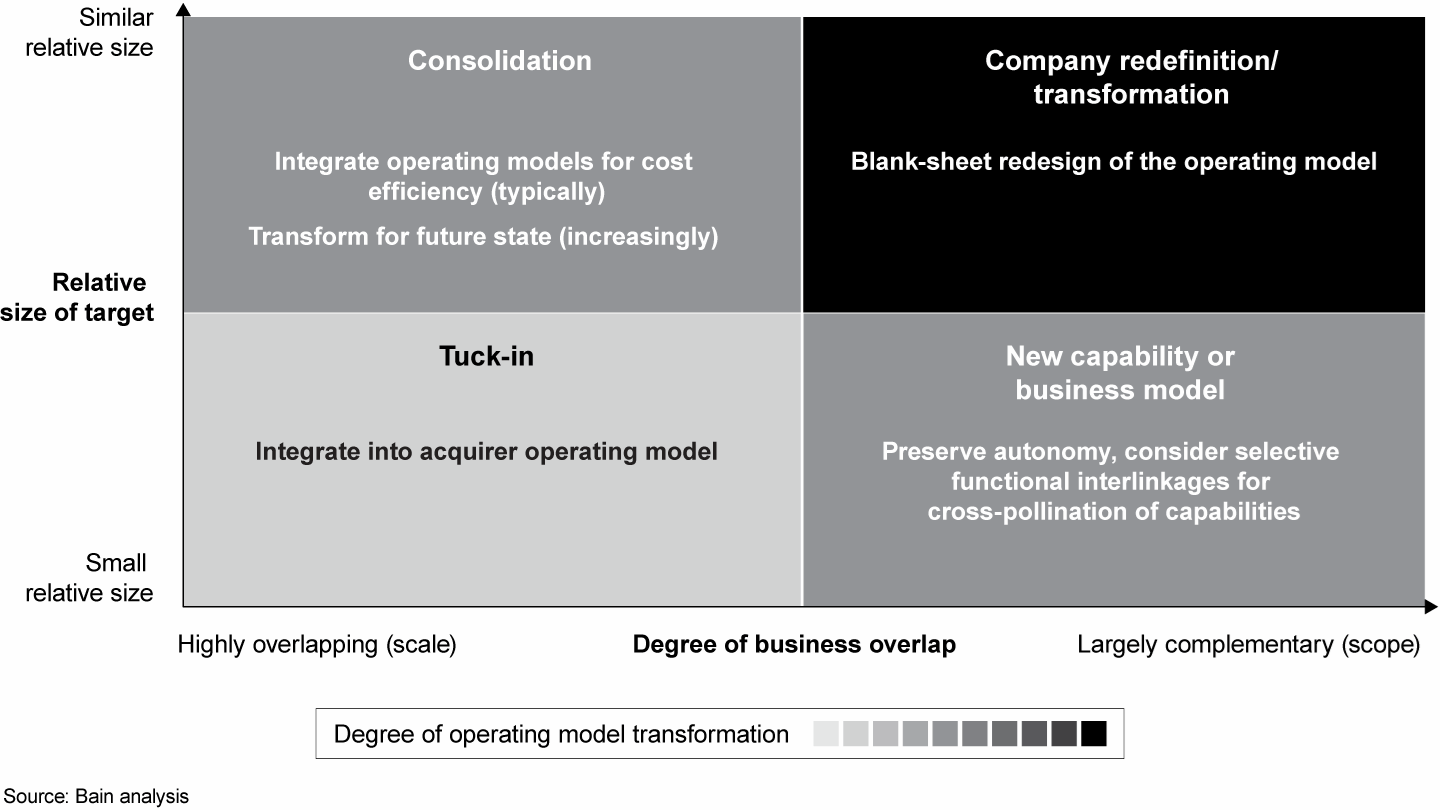
Scale deals between industry incumbents provide an opportunity to transform
The top-left box in Figure 3.3 is the most familiar—scale deals between two companies with similar business models intended for consolidation and cost efficiencies. These combinations generally don’t call for an operating model redesign, but two situations may prompt greater change: The first is when the organizations have very different operating models to start with; the second is when the merging companies are in an industry being disrupted and the integration presents an opportunity to make transformative changes.
Let's take the Ahold Delhaize food retail merger as an example in which both of these factors played a role. Similar to most incumbent grocery retailers, Ahold and Delhaize were caught between the hard discounters that are driving down cost and the emerging challenge from digital natives that offer consumers a radically different delivery model.
In response, Ahold and Delhaize came together in a $28 billion scale merger of equals. While both businesses were headquartered in Benelux, they had significant business overlap in the US. The US operating model needed to be transformed to strengthen the local commercial focus through its great local brands while also delivering sizable synergies. This was a challenging transformation effort given the merger’s scale (more than 204,000 associates and a 2,000 multiformat store base in the US), the companies’ existing operating models and the need to create a new support services entity.
Ahold Delhaize USA companies chose to adopt a brand-centric operating model. The brand-centric operating model allowed the US brands to benefit from scale and best practice sharing. Many commercial functions were placed on the brands to drive local brand strategies, tailor execution to the local brand’s customers and combat local competitors. This transformation required US companies to undergo fairly substantial changes, such as:
- redesigning roles for 4,000 positions;
- defining decision rights and governance within the brands; and
- managing the change of associates into their new roles and organizations.
The transformed operating model enables Ahold Delhaize USA companies to better respond to local market dynamics through independent, local brand operating units while also delivering substantial cost synergies. The margin improvement will help fund capabilities for the future, including e-commerce. In addition, the support services company will be able to better provide innovation abilities. For example, Ahold Delhaize USA recently launched Peapod Digital Labs, a new services company to spur digital and e-commerce innovation and technology.
Operating model changes unlock the value in scope deals
The right side of Figure 3.3 contains the world of scope deals. We probe three decisions relating to the operating model that are most critical: organization structure; governance and decision making; and ways of working and culture.
What organization structure will allow for greater combined business growth, innovation and capability transfer? The old model for scope deals was often to leave the company on a relatively standalone basis. With the advent of scope deals to build a new capability or to transform the base business, the interlinkages need to be much stronger. This requires more deliberate structural decisions.
Let’s consider two examples to illustrate these options.
When Medtronic, a global medical device company, announced the acquisition of Mazor Robotics, the manufacturer of a robotic guidance system for spinal surgery, it announced a full integration. Mazor’s team and product portfolio would be fully integrated into Medtronic. With an aim to accelerate robotic-assisted surgery in the spinal market, Medtronic and Mazor are working to fully integrate Mazor's robotic-assisted surgery systems with Medtronic's spinal implants, navigation and intraoperative imaging technology.
In contrast, Thales, a leading French aerospace and defense company, plans to establish a new global business unit upon the completion of its proposed acquisition of Gemalto, a digital security company. Combined with Thales’ existing digital businesses, this new business unit would represent 20% of combined company revenue and be a global No. 2 player in digital security. By establishing an independent business unit, Thales will create a stronger platform for growth with its digital businesses, providing Gemalto with adequate autonomy and distance from the base business to chart out an independent path.
Where do the decision rights lie, and what are the rules of engagement? Beyond organizational structure-related decisions, scope acquisitions also prompt questions around how the leadership teams make critical decisions. We’ve seen plenty of examples in which burdening the acquired asset with the acquirer’s bureaucratic decision making, budgeting or performance evaluation styles can crush growth. Growth companies have an entrepreneurial mindset and a decision velocity that is fundamental to the speed at which they operate.
Two critical questions arise around decision making and governance in scope deals.
- Which decisions should stay with the acquired company vs. the acquirer?
Successful practitioners begin with a minimum set of nonnegotiables and guardrails that set the boundaries for decision making. These are based on the critical elements of being part of any organization—adherence to group vision and core values, financial reporting requirements, legal and tax compliance, and corporate affairs.
Beyond the required minimum, strategic decisions that directly affect growth, such as those relating to products, customers or talent, should stay with the target to protect decision-making velocity. It is particularly important to give more autonomy for decisions that are reversible (two-way decisions), while establishing a more extensive protocol for irreversible (one-way) decisions.
- Does the new business require new ways to measure success?
Growth assets typically require different metrics to track performance. Industry incumbents need to be prepared to break away from legacy ways of thinking about performance tracking. For instance, while the growth and profitability performance of established brands can be measured by scale-oriented metrics, the same metrics could unfairly penalize growth brands. Acquirers need to be flexible to incorporate more customer-oriented metrics and take a longer-term performance view, depending on the stage of development or maturation of the acquired asset.
What should be the culture integration approach? For scale deal integrations, we’ve held the view that the culture across both the acquirer and acquired needs to be unified at some point. The role of management was to understand the different cultures and pain points, define the ideal future culture, and take action to align them.
The issue on how to handle widely different cultures gains greater importance in scope deals, since more of the value in these deals resides in the people, culture and capabilities. As such, the role of the parent company changes. The parent company management still needs to understand and identify the right cultures, but it also needs to be able to accept, adopt and model multiple aspects of those acquired cultures, potentially including new and disruptive elements.
Culture differences are not always a problem or issue, and a few companies have been able to bring valuable agility and new ways of working to the legacy organization.
Microsoft is perhaps the most prominent example of an incumbent that has made bold moves to embrace the culture, talent and capabilities of acquired businesses. This was done through unambiguous and consistent messaging around the future direction of the business that would change. Microsoft took some hard actions that included combining existing businesses under the leadership of the acquired digital native. This marked a strong departure from historic protocols on leadership appointments. Other softer actions, such as inviting young leaders to strategy summits, provided cues on the status of acquired businesses. These moves were consistently backed up by bold messaging from the top.
Closely linked to culture is the approach to talent management—recruiting, motivating and retaining a different talent pool from the base business. Once again, the historic methodology of adopting one talent management approach, typically that of the acquirer, can lead to a loss of talent and slowing of decisions. To counter this, more successful scope acquirers are maintaining separate physical spaces (different offices) and separate HR policies (for compensation and benefits, jobs titles and grades, career paths and so on).
In summary, each deal has different objectives and characteristics, and as a result, different operating model options. Selecting the right one can make or break the deal value. For transformative and scope deals, the work required is often complex and nuanced. Acquirers need to update their M&A playbooks to enable the right choices and realize the full deal value.
Process and systems integration—a new source of competitive advantage
At a Glance
- Effectively integrating business processes and systems is a key competitive advantage for top-performing serial acquirers, enabling them to capture benefits of the deal, better prepare for the next deal and jump-start wider transformation.
- Working with many of the highest-performing acquirers has helped us identify six things they do differently to create the most value.
- Looking ahead, the latest M&A trends continue to increase the importance of process and systems integration efforts, with scope deals, activist-inspired carve-outs and regulatory scrutiny creating more complexity.
- The best acquirers will learn how to manage this complexity and build it into their integration playbooks.
Effectively integrating processes and systems is a key competitive advantage for top-performing serial acquirers
Our study of serial acquirers shows how a repeatable M&A capability usually results in a differentiated capability to integrate business processes and related systems effectively.
Experience teaches us that process and systems integration done right, with the appropriate investments of resources and budget, builds a solid foundation for the future. This includes the ability to integrate future acquisitions quickly, to be ready for digital transformation and to maintain lower ongoing costs (see Figure 3.4). It’s also an area of integration that we see is often underresourced and in which costs can spiral quickly, making or breaking the deal value.
Inadequate process and systems integration increases complexity and costs over time

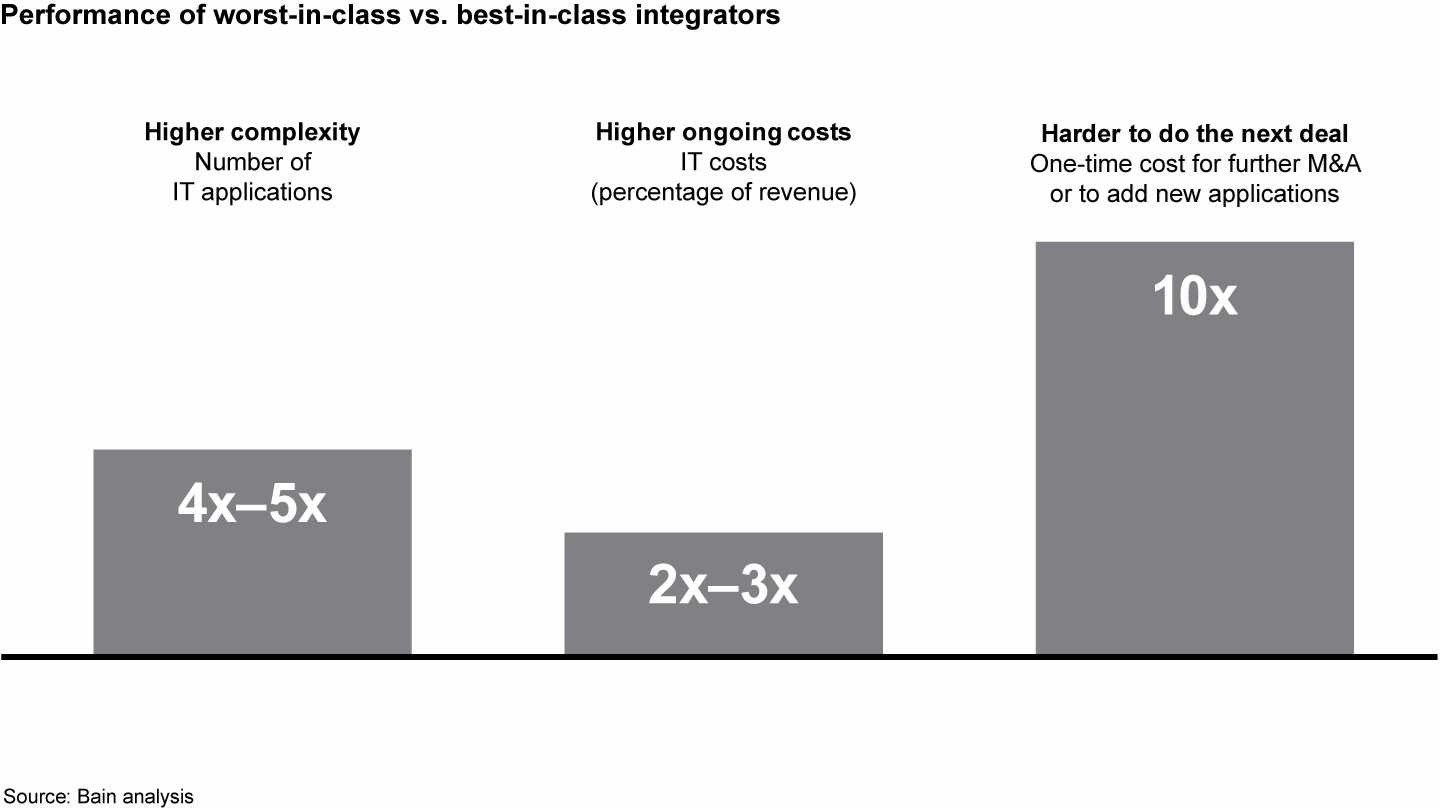
Looking at the best acquirers, we see six things they do differently.
- Align IT integration thesis to guide the integration effort
Choices for IT integration range from fully integrated to completely separate systems. Usually, the level of integration adopted falls somewhere in between, depending on the deal thesis and starting points of the system architectures of both companies. The integration thesis then guides the systems selection.
In scale deals, typically the full stack of a systems spine, comprising core enterprise resource planning and master data, is selected from either the acquirer or target based on future fit, enabling one company to migrate to another company’s systems. This is the cheapest and fastest way to integrate, but it may come at the risk of losing some good systems. Related to this approach, core business processes are similarly adopted from either one to minimize process changes. Beyond the systems spine adopted from either company, for systems of differentiation, some companies take a best-of-breed approach, which the modularity of new architectures makes easier.
For instance, in a recent insurance merger, the IT integration thesis called for adopting the systems spine of one company to enable easier migration of the core systems. For digital and other differentiating capabilities (for instance, data lakes, robotic process automation), however, a best-of-breed approach was adopted from either company.
- Integrate processes and systems with speed
We see the best acquirers move with speed to capture synergies earlier and also to reduce the risk of talent loss and distraction from extended integration periods. Speed matters a lot. In fact, according to our estimates, more than half of business synergies are often contingent on systems integration. Faster systems integration enables faster realization of revenue and cost synergies, earlier introduction of new technological capabilities, as well as the ability to present a single face to the customer earlier. On average, we see the best acquirers complete about half of the systems integration within the first year of closing and the remaining half within two to three years of closing. This is the average—it takes much longer in certain industries.
- Appropriately allocate resources and budget
Proper IT integration requires investments that many companies fail to make, leading to complexity and spiraling costs down the line. Faster integration calls for even higher investment and resourcing.
That said, to ensure a better return on investment, we also believe there is a need to optimize the amounts being spent on IT integration. We’ve seen that even when companies make the necessary investment, the huge estimates for systems integration costs are further overrun by 20% to 50%. Indeed, companies need to reevaluate preclose systems integration cost estimates. For example, in two large scale acquisitions in the consumer products industry, we found that there were opportunities for 40% to 50% cost reductions on preclose systems integration cost estimates without any impact on value delivery.
- Protect digital agenda while advancing integration
With digital transformation front and center on the IT agenda for most companies, simultaneous integration leads to competition for resources. Good prudence suggests minimizing the risks—when it comes to deciding between integration and digital transformation efforts, the former should take priority. Systems integration typically takes two to three years to execute fully, however, and the business often can’t wait that long for critical technological capabilities, such as cloud infrastructure, robotic process automation, wide area network and analytics capabilities. In our experience, to make progress in parallel to integration efforts, the best acquirers insulate their digital agenda by protecting the resources and budgets allocated to the top digital initiatives.
- Adopt best of both IT talent, with consideration for transition needs
Quality IT talent is among the most in-demand and hardest to find. Regardless of the integration approach adopted, talent selection should be the best of both and not depend on the systems selected. Talent also needs to be chosen based on the short- and medium-term needs for the integration itself, retaining the must-have talent for specific systems to ensure smooth migration.
- Reassess IT approach and costs at the time of integration
IT integration costs and, more broadly, IT operating costs are substantial for most companies and are often rising rapidly. Many companies use traditional approaches in due diligence when setting IT cost targets by basing them on historical benchmarks. At times, the need for regulator-mandated remedies often complicates and drives up one-time IT integration (and separation) costs. These are typically not accounted for at the due diligence stage.
We believe historic benchmarks do not reflect the current reality of the structurally rising IT costs resulting from digital transformation efforts and other transactional complexities. As such, integration and transformation initiatives cannot be viewed separately and require a combined roadmap and business case to avoid cost surprises down the line. Getting the full roadmap and cost targets right means greater scrutiny at the time of diligence. Fact is, once the deal is done, it is too late.
To see how these principles were put into action, consider the merger of First Gulf Bank and National Bank of Abu Dhabi to form the United Arab Emirates’ largest bank and one of the top five in the Middle East, with a market capitalization of around $30 billion at the time of the merger announcement. While the banks were erstwhile competitors operating with similar product portfolios and complementary market positions, there were significant differences in how each bank operated. This was also an integration involving two large, full-service, universal banks, adding tremendous complexity to the overall integration, particularly process and systems integration. Neither bank had done a merger of this scale nor a systems integration of this nature.
First Abu Dhabi Bank, or FAB as it is now known, adopted the best-in-class principles, ultimately delivering full IT integration within 20 months compared with an initial timeline of 24 months (and the minimum 36 months it takes for most acquirers in banking). This gave the bank significant advantages. It moved to business as usual much earlier than would otherwise be possible. In one of the business units, the systems integration was complete in nine months, allowing for an even faster return to regular business operations.
Let’s look at some of the ways that this was made possible.
A robust business footprint and as-is IT fact base for both organizations informed the options and potential choices for the IT integration thesis for the combined entity. These included choices to adopt systems from either company, take best of both or adopt new solutions for key IT components. Instead of a time-consuming bottom-up approach, the integration leaders invested the time up front to align top management on the IT integration thesis and guiding principles. The move was critical to get a head start and avoid roadblocks later.
The up-front guiding principles spelled out the need for a speedy integration to enable a single face to the customer and operations as one bank, with full integration within 24 months. A number of other decisions supported this goal—the decision to migrate first, add capabilities later; fix go-live dates early; minimize additional in-flight projects and requests for additional capabilities; and adequately allocate resources toward the integration effort.
Senior management aligned on the IT integration thesis within six weeks of integration kickoff, with broad buy-in. Within three months, the thesis was confirmed and highlighted any gaps in understanding before moving on to the detailed planning. Detailed integration planning before day one enabled integration teams to be ready to start implementation soon after close and to complete the full integration effort in record time.
Recent trends in M&A are likely to increase the complexity and choices for acquirers
At first blush, scope and capability deals may require less process and systems integration, with fewer synergies impacted and fewer overlapping processes. Given the required link to the operating model, however, these deals actually bring far more options to the table. To determine the right process and systems solution, many questions will need to be answered. For example: Will the acquired business be kept separate or fully integrated? What functions will be linked to the base business? What distinguishing systems or technological capabilities do we need to bring back into the base business?
To help answer these questions, companies need to make a distinction between the approach for integrating front-end systems vs. back-office ones. Even when there is little or no integration for front-end systems, a greater degree of integration is required for back-end systems to move to a common platform for efficiencies and to enable easier future integrations. Also, there is value in moving to a shared infrastructure in terms of infrastructure-as-a-service, network and end-user computing.
As an example, Walmart Labs, the technology team at Walmart, is adopting common technology across Walmart digital assets (Walmart.com, Jet, Bonobos, ModCloth and so on). While the digital assets continue to operate distinctly, the technology team finds areas in which the digital assets would benefit from standardization, such as back-end systems and areas that are typically less customer sensitive. When it was acquired by Walmart, Jet did not have PayPal as a payment option. Now, the technology team is integrating payment options to be accessible across Walmart digital platforms.
The rise in regulation and activist involvement is also boosting process and systems complexity through the increased use of carve-outs, either as remedies or as part of portfolio management. These carve-outs require companies to separate or migrate processes and systems ahead of day one. They also typically introduce the need for wide-ranging transitional service agreements that bring added complexity and risk to the integration process.
Section 4: Industry focus—M&A in consumer products
In this penultimate section, we pull together the major insights and themes covered in our first M&A report for the consumer products industry to illustrate how they are playing out on the ground.
At a Glance
- The last decade saw many megamergers between consumer product companies in the pursuit of scale efficiencies and market-leading positions. This was a tried and tested formula to boost earnings growth and margins.
- Over the past couple of years, industry disruption and growth challenges have upended this trend. Insurgent brands have captured a disproportionate share of category growth.
- Against this backdrop, the major M&A trends are playing out.
- To be successful in the new environment, the best consumer goods companies are updating their M&A playbooks across strategy, diligence and integration approaches.
Consumer product majors face growth disruption
Over the past couple of years, disruption and growth challenges have changed the consumer products industry. For instance, today, an outsized share of category growth is captured by insurgent brands rather than incumbents (see the Bain Brief “How Insurgent Brands Are Rewriting the Growth Playbook”).
Large consumer products companies have seen disruptive changes in the external environment. These changes are often ultimately driven by digitalization but also include the rise of digital retail, the march of low-cost retailers, and the emergence of online and offline retail ecosystems. These factors, combined with an internal focus on bottom lines, have led to significantly lowered growth rates over the past several years (see the Bain Brief “Overcoming the Existential Crisis in Consumer Goods”). There are notable exceptions, of course, such as in the beauty category, in which incumbents have held up growth and market share just fine. That said, the overall growth challenge posed by faster-growing insurgent brands and a redefinition of the benefits of scale represent new realities for most consumer goods companies.
While scale was very important during prior years—for example, in media buying, retailer negotiations and go to market—the rise of social media and e-commerce has lowered barriers to entry for smaller players. As a result, an outsized share of incremental category growth is going to insurgents (defined as brands that are less than 25 years old, growing at more than 10 times the category growth rate and with revenue in excess of $25 million). These companies are typically nimbler than incumbents and better able to identify and address unmet consumer needs in specific niches. They don’t need to match an incumbent’s legacy infrastructure to compete. Instead, they easily utilize the contract manufacturing and distribution ecosystems to operate and digital marketing to reach target consumers cost effectively.
By comparison, established consumer goods companies’ attempts at innovation have yielded a patchy record. Legacy ways of working mean that they are slower to come to market with innovations and limited in their ability to test and learn in an Agile fashion.
Large consumer goods companies are responding to this challenge through short-term actions, such as trading off margins to regain market share and also by changing the types of deals they are undertaking.
Against this backdrop, let’s see how the five M&A trends are playing out.
- Acceleration in scope deals
Over the past decade, we’ve seen a wave of consolidation in the consumer goods space, with some of the largest deals inked—including the likes of Anheuser-Busch InBev and SABMiller, Coca-Cola bottlers’ integrations in Europe and Japan, and Mars and Wrigley, among many others.
The nature of deal making has changed over the past three years—more consumer goods company M&A activity involves scope-oriented deals to enter faster-growing product segments or acquire growth brands. Some incumbents may continue to make defensive scale deals where allowed, but we see them making more offensive moves, indicating a step change in the use of M&A to acquire growth (see Figure 4.1). Some of the prominent scope deals announced in 2018 include Keurig Green Mountain’s merger with Dr Pepper Snapple, Coca-Cola’s acquisition of Costa Coffee, General Mills’ acquisition of Blue Buffalo Pet Products, and Mars’ acquisition of two veterinary chains in Europe, AniCura and Linnaeus.
Acceleration in scope-oriented M&A in consumer products

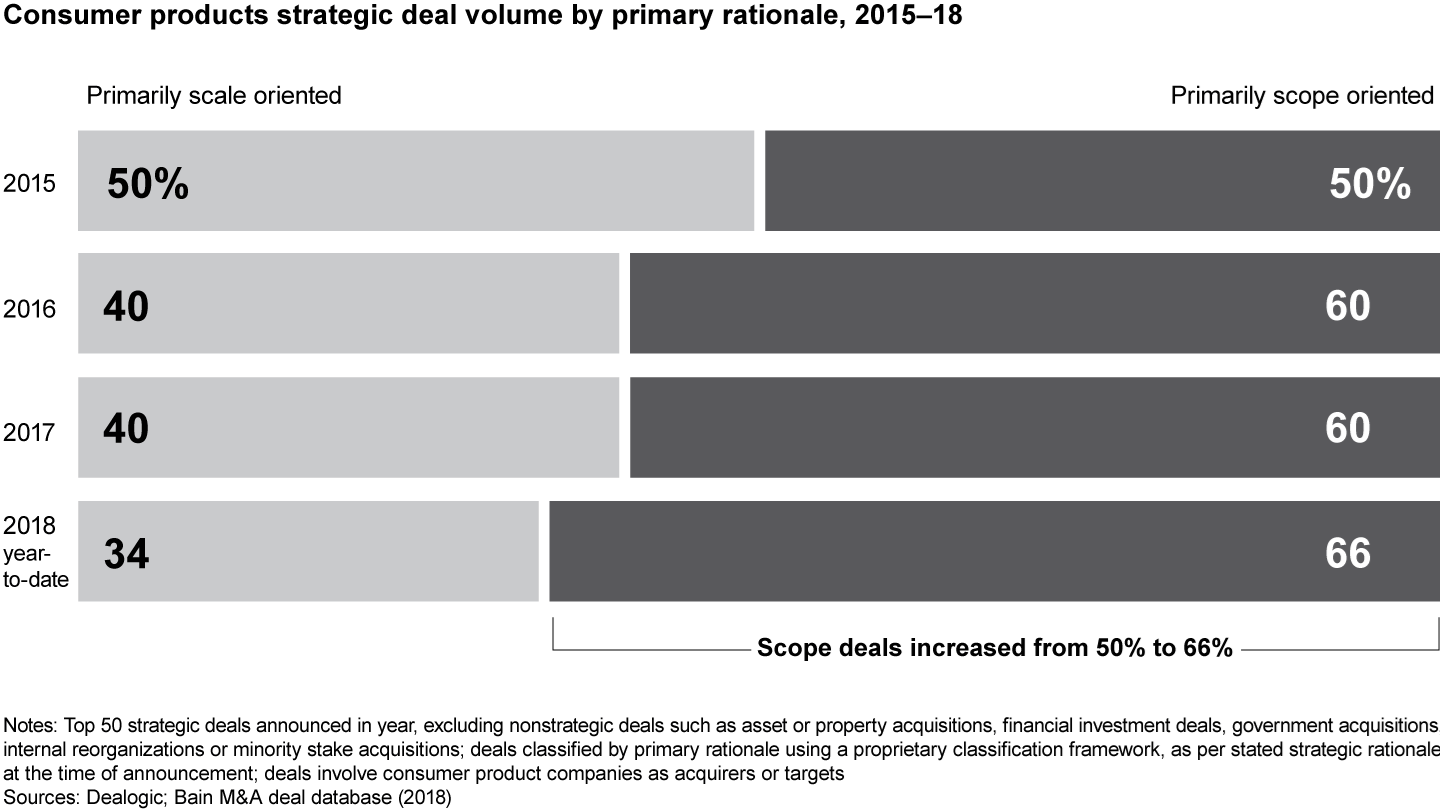
- Financial sponsors are eager buyers for noncore portfolio holdings
Financial sponsors are actively involved in the consumer products industry. They are bidding for most consumer product carve-outs that come on the market. They are proactively approaching consumer product companies with an offer to buy assets that are not yet on the market. They are also establishing platforms and growing them through add-on deals. These trends have been building for a while, illustrated by players such as 3G Capital and JAB Holdings.
For consumer products companies, this increases the competition for attractive assets but also provides options to exit parts of the portfolio. A recent example: Unilever’s sale of its spreads business, now called Upfield, to KKR for $8 billion.
- Consumer product majors were prominent targets for activists
Activist investors are continuing to pressure consumer products incumbents to reshape their portfolios. This is no longer a US trend limited to the likes of Campbell Soup and Procter & Gamble. Given the strength of the US dollar and strong shareholder rights in the EU, the trend has moved into Europe—think Danone and Nestlé. Global consumer goods companies now need a proactive approach to managing and strengthening their portfolios, with a sharp eye to the value they add category by category. To avoid being surprised, many have learned to look at their business proactively from an activist lens. As incumbents seek to transform their businesses to be nimbler, with more focused category leadership, we will likely see a continuation in the spate of divestitures.
- Expectations of continued regulatory scrutiny
Within domestic boundaries, many consumer products categories are reaching the limits of allowable consolidation. Thus, regulation continues to constrain further consolidation in many categories and regions.
The consumer products industry has been relatively insulated from cross-border deal scrutiny, which has focused on other industries deemed important for national interest and security. That said, in 2013, China-based Shuanghui’s (renamed WH Group in 2014) bid for Smithfield, the world’s largest pork producer, required a CFIUS review on grounds of national interest. There is nothing to say that such scrutiny won’t happen again for some deals.
Cross-regional deal making has normalized since the peak in 2016

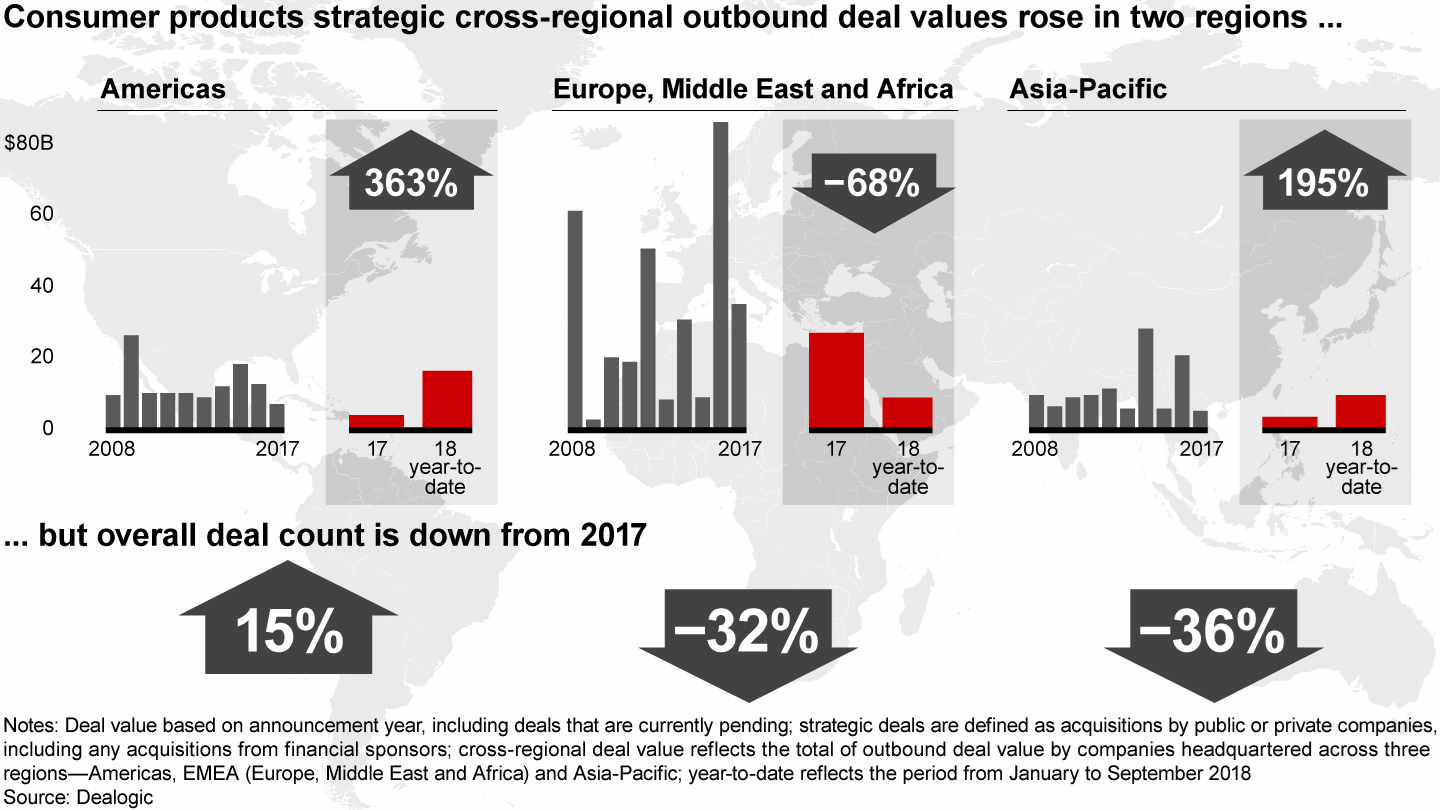
- Cross-regional deal making in line with historic levels
In line with the global trend, deal values have dropped in consumer products’ cross-border activity since the peak in 2016. Due to increased interest by US-based and Asia-Pacific-based acquirers in attractive growth assets, however, deal values in 2018 have partially rebounded (see Figure 4.2). The key deals by US-based acquirers were Coca-Cola and Costa, Procter & Gamble and Merck’s consumer health unit, and PepsiCo and SodaStream.
To be successful in this environment, the best consumer goods companies update their approach to M&A across key areas, including M&A strategy, due diligence and integration approach.
Proactively defining M&A strategy
M&A strategy, more than ever, is the critical starting point to acquiring the assets and capabilities to support broader growth. The best consumer goods companies take a highly proactive approach to defining their M&A strategy. In today’s disruptive environment, two approaches are coming to the fore: embedding future-back thinking; and taking a broad portfolio methodology to deal making.
Embedding future-back thinking
Meeting today’s growth challenges requires taking a today-forward view of the business. This means looking hard for sources of growth and cost levers in the existing business footprint (see Figure 4.3). Fundamental business transformation, on the other hand, requires taking a future-back view, forming a vision of what the company should look like five years from now and redefining the corporate identity. Combining these views together should be the starting point for M&A strategy.
Consumer product majors embed future-back thinking into strategy

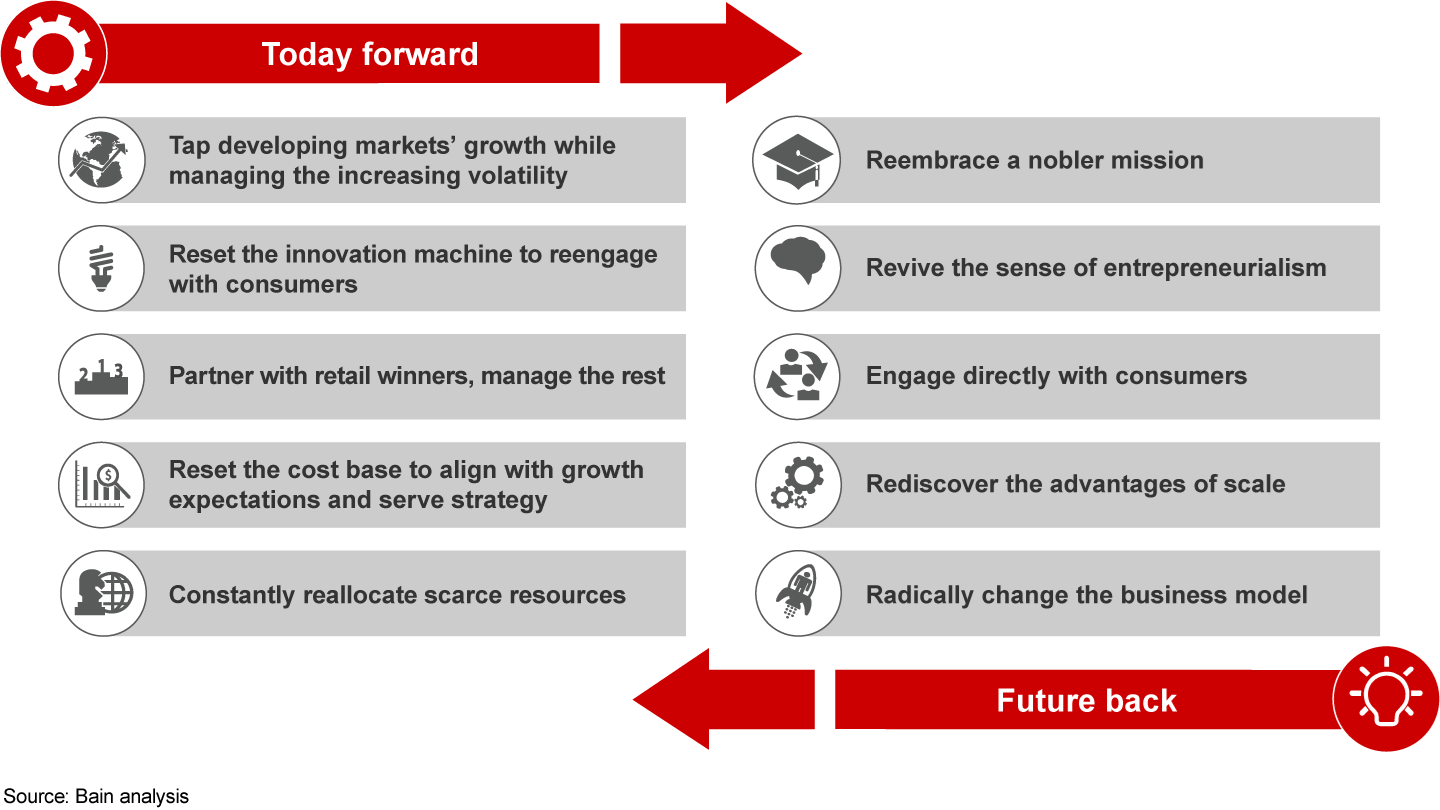
Taking a broader portfolio approach to deal making
To grow, internal R&D may need to be reinforced with M&A, corporate venturing and other forms of external R&D (for example, open market innovation platforms, tech labs/research centers). M&A strategy thus moves beyond market consolidation motives to guide the assets and capabilities that the company needs to acquire to fulfill a future-back mission.
We believe scale deals will continue to be prevalent in certain segments of the industry where this may still be permissible. This allows incumbents to use combined scale to boost near-term earnings growth and provide room for investment. In addition to category-level differences, there are regional differences, and scale deals will continue to be relevant in many parts of the world.
However, we expect the incidence of scale deals to be lower than it has been in the past. We also expect a continuation of more growth- and capability-focused deal making as the long-term strategic focus pivots to the top line.
Let’s consider three M&A approaches to show how market leaders are reacting to the broader growth challenges in the industry.
- Scale insurgent acquisitions: Nestlé, a global food and beverage company, has doubled down on coffee as one of its biggest growth opportunities and has made three notable deals in this space over the past couple of years. The largest of these, a $7.2 billion deal for the retail distribution rights for Starbucks’ packaged coffee business, is intended to increase its coffee business in the US while also leveraging Nestlé’s overseas retail distribution network to grow Starbucks’ packaged coffee retail sales.
The other two acquisitions were a bit different. They provide access to a growing product proposition—organic coffee in this case. Nestlé acquired a majority stake in California-based Blue Bottle Coffee, an artisanal coffee chain with about 40 stores in the US and Japan, for roughly $500 million, and Texas-based Chameleon, an organic cold brew producer. The acquisitions of these insurgent brands strengthen Nestlé’s presence in the fast-growing premium coffee segment as consumer preference shifts toward high-quality, sustainable coffee. In turn, Nestlé provides the financial backing and retail distribution expertise to grow the acquired brands’ ready-to-drink and packaged ground coffee products.
- Cross-sector acquisitions: The second M&A approach is one involving the expansion of traditional business boundaries through cross-sector moves. Today, pet care is one of the fastest growing and most profitable growth sectors as consumers spend more on premium products, healthcare and treatments for their pets. Unlike competitors’ moves to purchase other pet food manufacturers or online pet food retailers, Mars, a major confectionary and pet food manufacturer, is quickly expanding its pet healthcare business with multiple cross-sector acquisitions. Mars is redefining its own business boundaries by establishing a direct presence in pet healthcare and scaling it quickly. To do this, Mars acquired Europe-based Linnaeus and AniCura in 2018, and made multiple acquisitions in the US—VCA in 2017, Pet Partners in 2016 and BluePearl in 2015. Its original foray into pet care took place in 2007, when it bought a majority interest in Banfield.
- Outsourced innovation by investing in smaller brands earlier through corporate venture capital investments: Most large consumer products companies now engage in corporate venture capital investing. Within any corporate venture capital portfolio, only a handful of investments will be successful. Despite these odds, corporate venture capital investing can start with relatively little funding, with the option to increase the investment amount if performance criteria are met. At the same time, insurgent brands benefit from corporate venture capital know-how and connections. This makes being part of a corporate venture capital investment more attractive than regular venture capital or accelerator investments.
To complement its large M&A moves, Mars launched a $100 million venture capital fund aimed at backing start-ups focused on pet-related businesses. The investments vary from nutrition to genetics. For instance, in 2018, it acquired OptiGen, a genetic diagnostics company specializing in inherited eye disorders in dogs.
As another example, Diageo’s Distill Ventures enables it to make small bets on emerging brands as consumer preferences change to healthier alternatives within alcohol. Diageo retains the option to buy out any portfolio company at a future date. For instance, it acquired Belsazar from Distill Ventures in 2018. Belsazar makes a premium aperitif with ingredients sourced from Germany’s Black Forest. It caters to the growing consumer demand for long drinks and drinks with lower alcohol content.
The emerging approach of portfolio investing requires a reevaluation of the acquirer’s broader operating model. The acquirer should avoid burying assets within the existing base business or subjecting them to processes that hinder growth and innovation. Different cultures and talent pools need to be managed more autonomously—all this while ensuring that the asset can still benefit from the acquirer’s infrastructure and capabilities to enable growth.
Due diligence of insurgent brands raises very different questions from scale diligences
We’ve discussed the due diligence approach for scope deals extensively in a previous section. Here, we focus on what’s different about diligence for insurgent brands.
When acquiring insurgent brands, companies need to be able to articulate why they are the parent of choice. What are the incremental and scalable capabilities that can accelerate the target’s growth trajectory? Given the abundance of capital and willingness to pay high premiums for a growth asset, both parties need to be convinced about why the combination makes sense. Articulating the synergistic value is also a point of differentiation from PE players that may be looking at the same assets.
The acquirer also needs to be prepared to answer why the acquisition is the best investment for them within the available set of options.
For diligence, the focus is more on the future market potential, and how the brand penetration and consumer adoption will evolve. This assessment requires a future view of the world that is reinforced by activities such as product testing and consumer research. Fast-growing assets, especially early-stage ones, are particularly tricky to evaluate for potential profitability at scale, yet the ability to be profitable at scale is a key input into the deal model to justify the valuation.
We outline a simplified framework that many leading acquirers use. It assesses the future growth and profitability potential of insurgent brands. This is a structured way to assess brand fundamentals. It helps acquirers to increase confidence and clarity about how brand penetration may evolve and how they can use their own infrastructure and capabilities to accelerate it (see Figure 4.4).
Brand diligence checklist

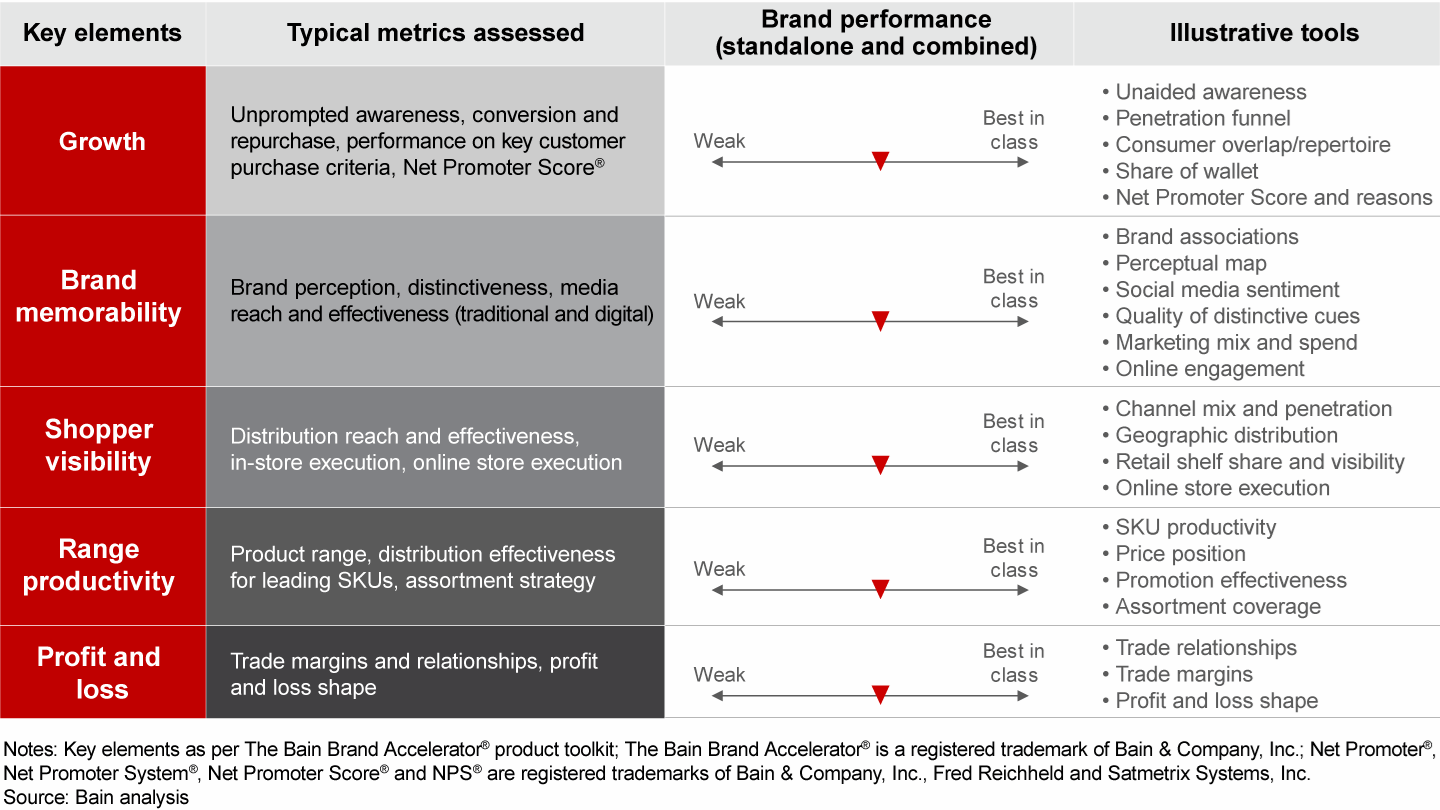
Given the high valuation levels for these growth assets, the acquirer needs to be comfortable that no matter how robust the diligence, some uncertainty remains and the deal may not deliver the expected value. While the potential growth rewards may be tremendous, so are the risks.
Risks and potential integration approaches when buying small brands
Consumer goods companies face unique risks when integrating smaller brands—for example, paying too much up front, scaling them too quickly, burdening them with business processes and planning, and losing critical talent. A wrong approach initially makes it more difficult to course correct later. The integration setup needs to ensure that the acquirer doesn’t crush the acquired asset under its existing weight and kill the very culture that led to the acquired brand’s growth.
The flip side of overintegrating—namely, keeping the brands entirely separate from the base business—doesn’t help to meet growth objectives either. The acquirer can end up with a portfolio of assets that don’t benefit from shared learnings or from the acquirer’s infrastructure.
Successful integration starts with an integration thesis that defines what needs to be integrated vs. kept separate.
Integration of insurgent brands needs to ensure that the founder or founding team have the independence to make the most strategic decisions in areas such as product development, specialized sourcing and branding. The functional integration approach in such deals requires an assessment of where to combine to gain scale efficiencies, where to keep the functions separate and where to invest to strengthen core capabilities. Integration approaches can allow the acquired company to opt in to any proposed functional integration.
For instance, when L’Oréal bought Urban Decay, it opted to leave product design and R&D separate to protect the target’s creative independence and maintain continuity for customers. On the other hand, procurement of select categories and production were combined to reduce costs through scale efficiency. In addition, sales and distribution were integrated to expand Urban Decay’s international footprint utilizing L’Oréal’s distribution reach.
Beyond processes, culture and ways of working are often the fuel that powers the growth of these insurgent brands. They need to be preserved by physical and personnel separation—keeping a separate headquarters, for example.
The jury is still out on which of the different M&A strategies outlined above ultimately will be the most successful, and in which situation. The questions around how to scale expensive acquired assets without harming them is a critical one and not easy to answer. As the early experiences of some consumer products companies show, clarifying the strategy and mission, developing a portfolio of bets, and adopting a fit-for-purpose diligence and integration approach will differentiate the winners of the future.
Section 5: Bain’s bedrock beliefs on how to create value from M&A
This report necessarily spends most of its time on what is new and different in the world of M&A. For example, we have argued that executive teams need to modify their playbooks to increase their odds of success when integrating capability deals.
All of that said, there are some fundamental truths about M&A that have stood the test of time. The analyses discussed below have been replicated multiple times over the past 20 years. The answer remains the same across all the different cohorts we have studied.
Headline: If you want to be successful at M&A, develop a repeatable model. Do it often, learn from your mistakes, and make it a material part of your business. Done right, it will generate higher shareholder returns.
Fast fact: About 94% of publicly listed companies participated in M&A in the last decade.
Bain Advisory Partner David Harding discusses how in the changing world of M&A, companies with repeatable models are best positioned to succeed.
We have assessed the returns to shareholders of the different M&A strategies employed by a universe of 1,729 publicly traded companies from around the world.
It turns out that two axes define a lot of what differentiates M&A performance—frequency (how many deals you do) and materiality (how much of it you do). We have outlined the returns of four groups of acquirers by deal frequency and materiality. The numbers in the boxes represent annualized TSR over 10 years for the companies that populate each box. The 6% of companies that did no M&A are shown to the side—their annual TSR was 5.5% (see Figure 5.1).
It does not take a lot of deals to become a frequent acquirer, about one per year. To be a material acquirer—that is, be on the right side of the chart—does require heft: 75% or more of your market cap from acquired companies over a decade. Still, 27% of all the companies in our sample were considered material acquirers.
Repeatable M&A is the winning strategy

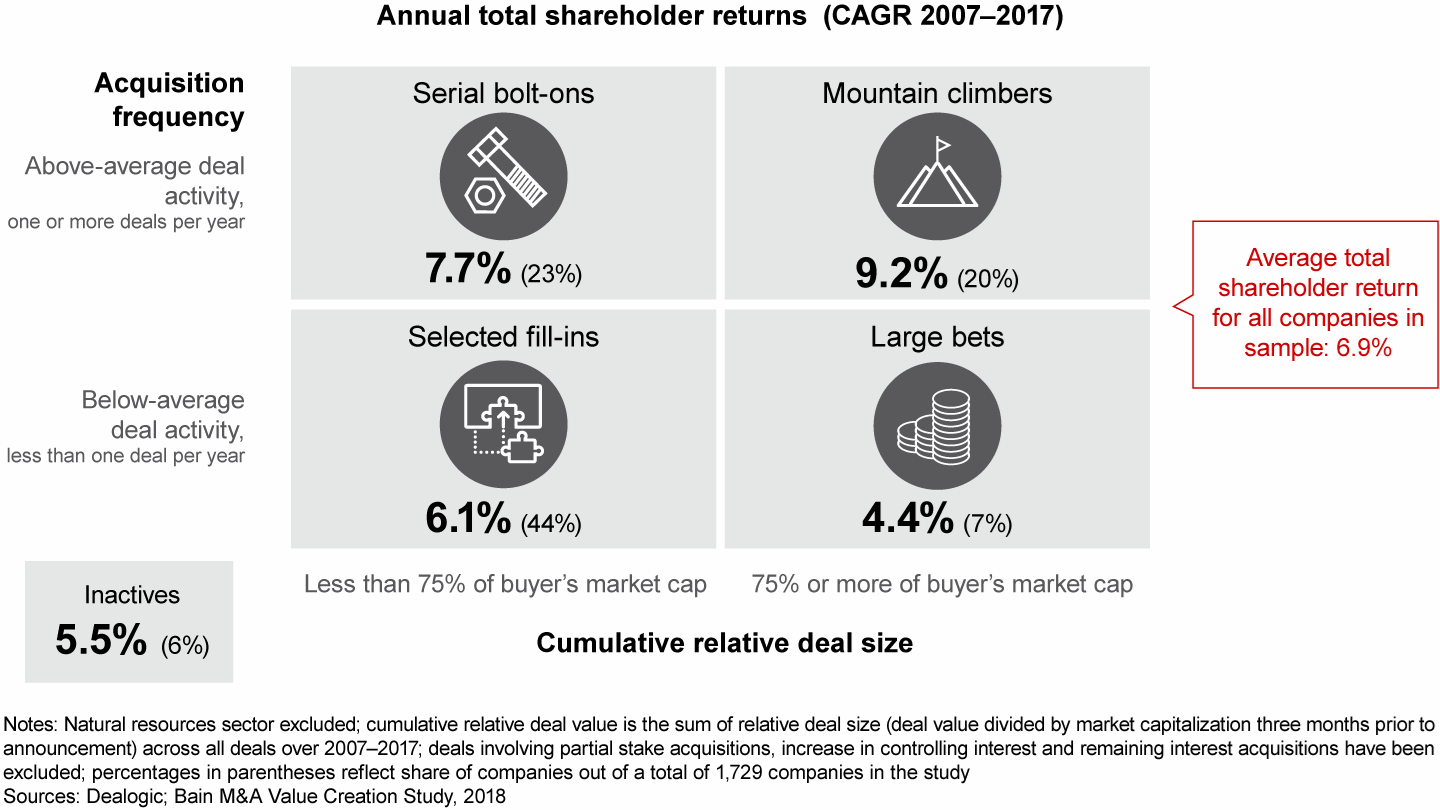
So what does the chart tell us?
First, consistent M&A activity over economic cycles contributes to higher TSR. This finding holds up year after year, across industries. Deal success and deal failure is more a matter of cumulative experience and capability in making a deal, and less a function of standalone deal circumstances.
Second, similar to most things in life, you get better at what you do when you do it repeatedly. Companies that acquire frequently (serial bolt-ons; top left in Figure 5.1) tend to outperform the average company on TSR (7.7% annual).
Third, companies that not only acquire frequently but also develop the capabilities to undertake larger deals do even better. We call these companies mountain climbers, and their 9.2% annual TSR leads the class (top right). Investors have come to recognize this.
We spend a lot of time studying mountain climbers to understand their distinguishing capabilities. Two of the mountain climbers, Anheuser-Busch InBev and Thermo Fisher Scientific, are highlighted in the following section. More broadly, we have identified and track 345 mountain climbers. Many are well-known success stories, including Apple, UnitedHealth Group, Amazon, Continental, Comcast, Microsoft, Safran, Stanley Black & Decker, Atlas Copco, Intel, Nestlé, BASF, Sony, Unilever, Walt Disney, SAP, Kering, Henkel and so on.
Mountain climbers follow an integrated approach to managing M&A from strategy to integration, which strengthens and reinforces their repeatable M&A capability with each deal (see Figure 5.2).
If done right, M&A creates value—especially with a repeatable model built upon a disciplined M&A capability

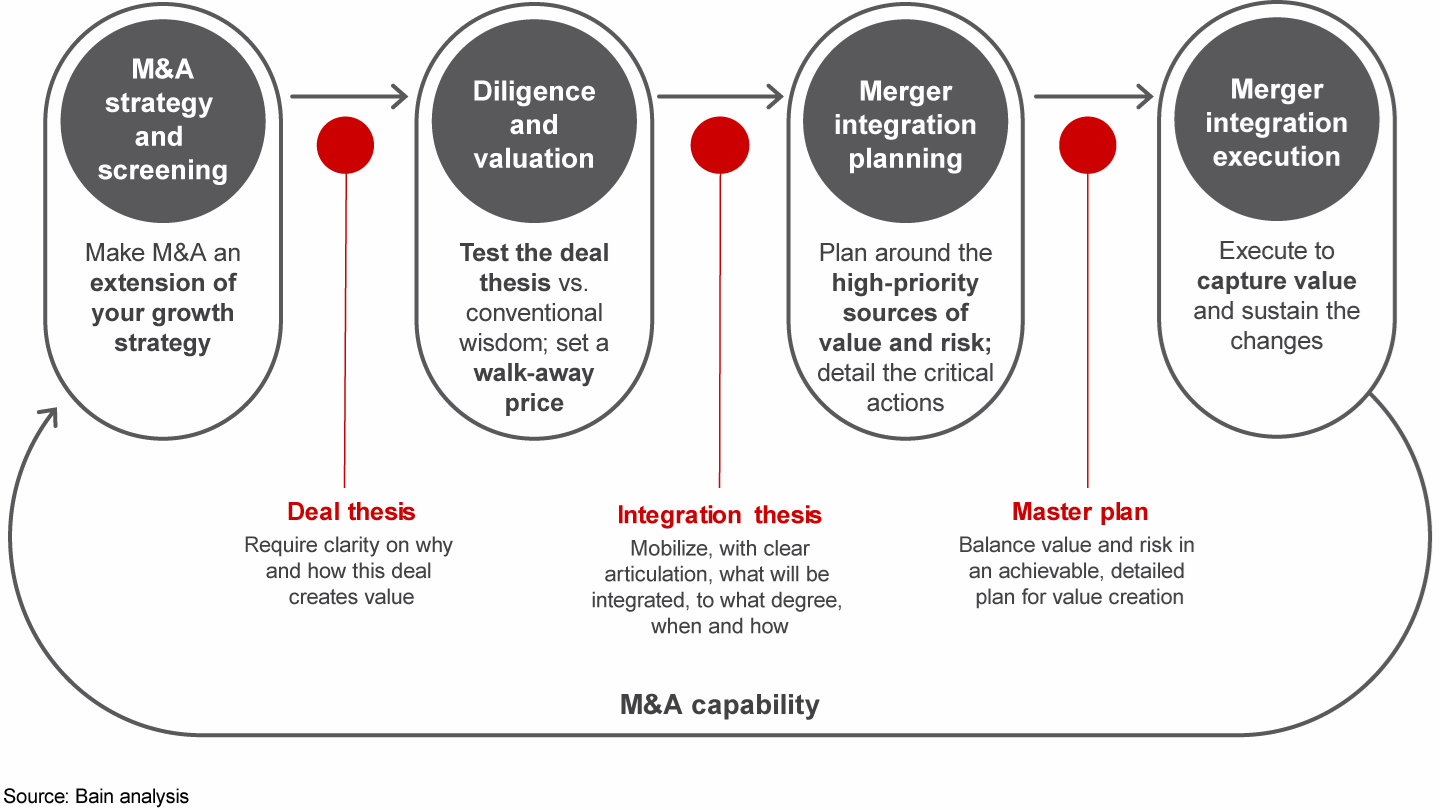
In addition to being frequent and substantial acquirers, mountain climbers also proactively manage their portfolios by pruning noncore businesses. It’s another big factor that contributes to their success. According to our analysis, roughly 96% of mountain climbers divest, and the average mountain climber will divest about 20% of its market capitalization over a 10-year period. These companies deploy a repeatable process for systematically identifying assets for divestiture and preparing them for sale.
Another big learning from our study comes from the failure of companies that make infrequent, big bets. We refer to such companies as “large bets”—they are infrequent acquirers but undertake large deals relative to their market capitalization. Among all companies studied, these are the worst performers over time as their limited acquisition experience, combined with investment in a large deal, usually results in poor deal outcomes. They generated only 4.4% in annual TSR from 2007 to 2017.
Going forward, an even higher premium will be placed on building a repeatable M&A capability that delivers successful outcomes across multiple deal types—small and large, scale and scope. The leap from small deals to large deals is a big one, as is the one from scale deals to scope deals. We believe that the new wave of M&A—in particular, those involving capability-driven scope deals—will require a fundamentally different approach to realize the value. Companies will need to adapt and modify their diligence and integration playbooks as they pursue scope deals for growth and, potentially, more transformative capability-driven scope deals.
What mountain climbers do differently
While every company will have a distinct strategy and M&A roadmap that accounts for its industry and competitive dynamics, we’ve distilled some of the practical actions mountain climbers take to underpin their repeatable M&A capability. What we have learned is that there is no silver bullet that guarantees success. Instead, we see the best rigorously applying learnings from past deals across the entire M&A process to increase their chance of success. Here we show two representative but fairly distinct approaches that have powered two companies toward winning in their respective industries.
Anheuser-Busch InBev, the world’s largest brewer, has used a repeatable M&A model and capability to drive strong growth and value creation over the past decade.
What drives Anheuser-Busch InBev’s repeatable M&A capability?
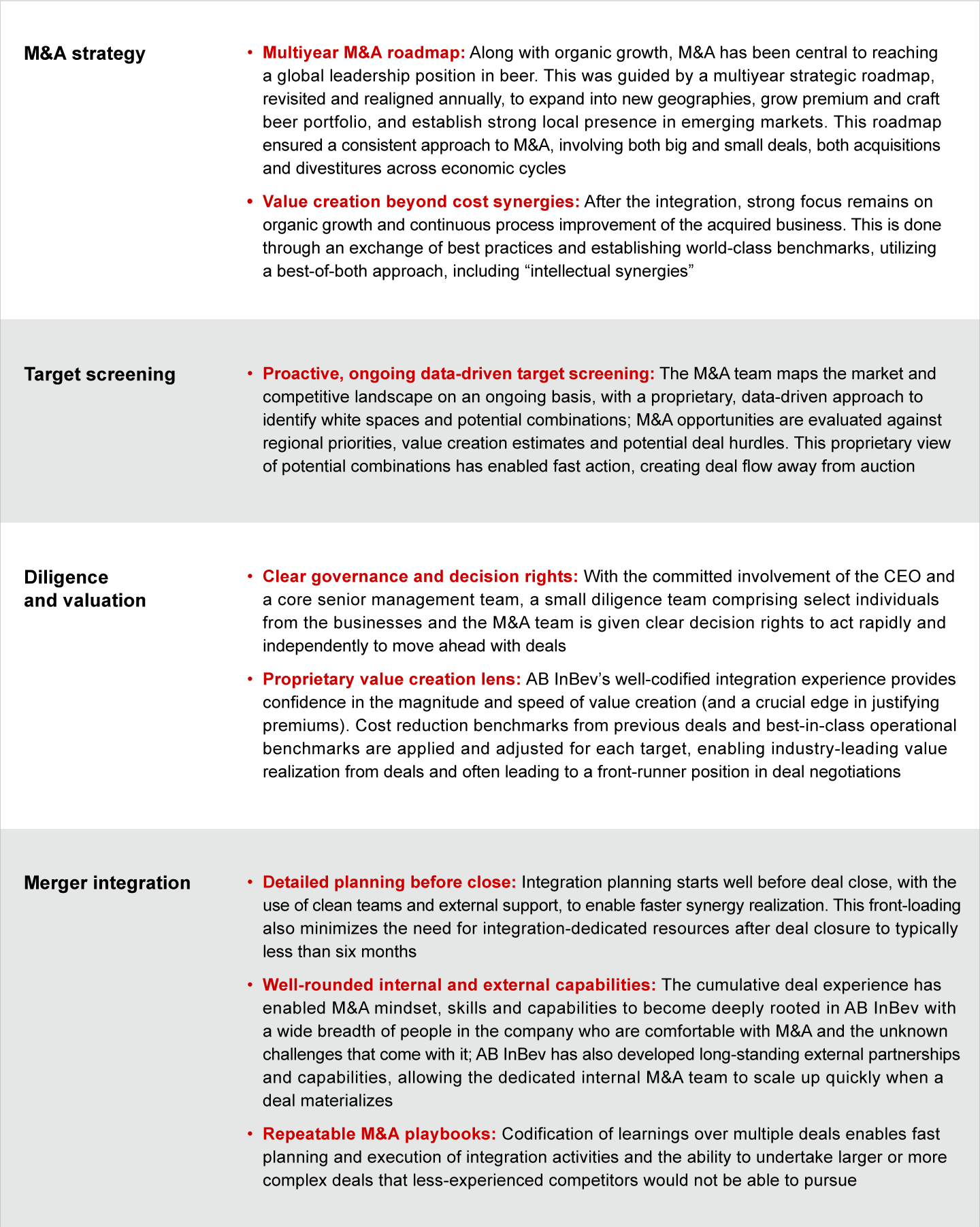

Thermo Fisher Scientific, a leading US biotechnology product development company, has brought together several acquisitions over the past 10 years to deliver a more than sixfold increase in its share price. Its M&A capability is widely recognized as a strong differentiator and a sustainable growth lever.
What drives Thermo Fisher Scientific’s repeatable M&A capability?
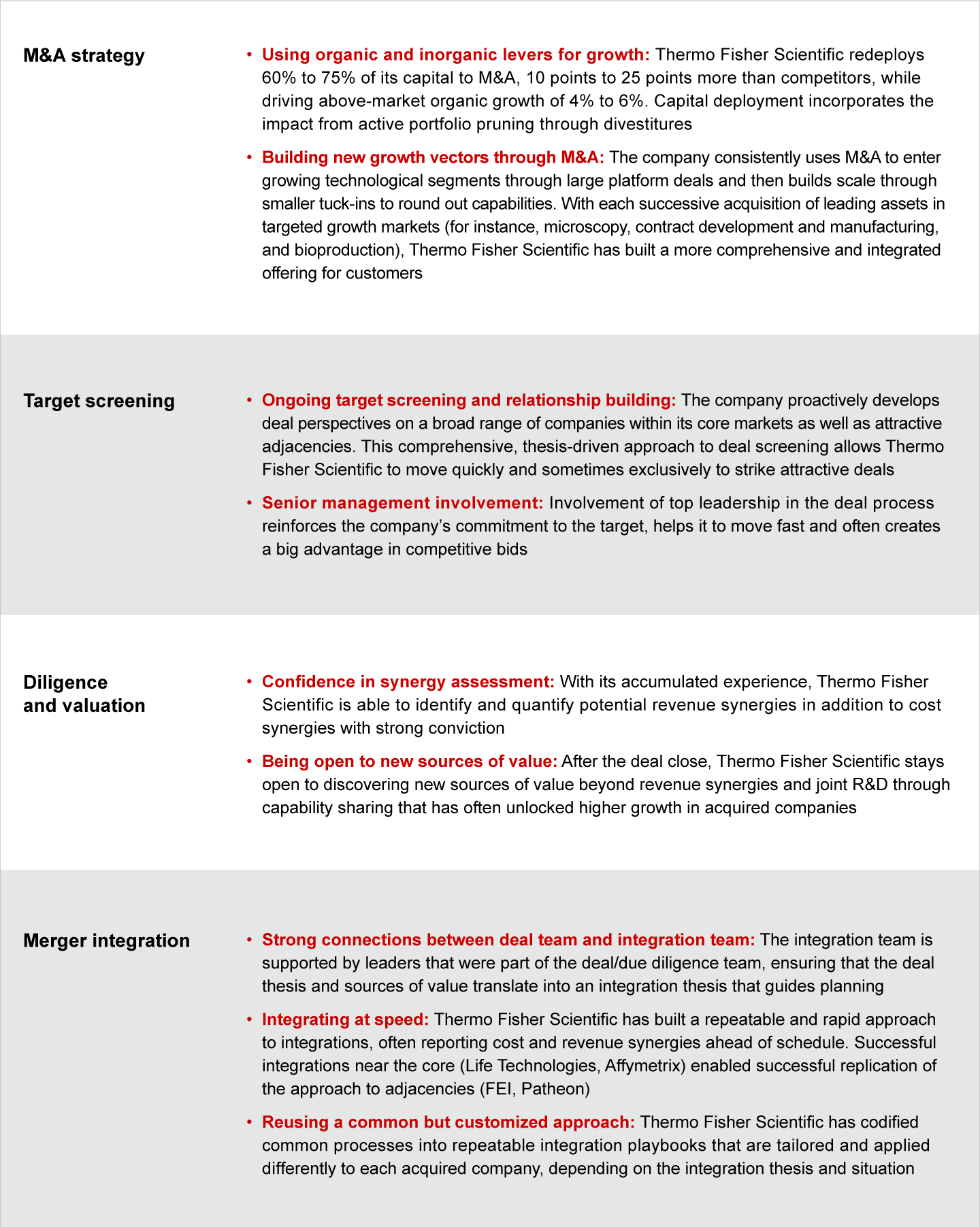

Methodology and approach
About deal classification into scale and scope deals
To understand the nature of M&A activity, we first identified the top 250 strategic deals of each year (top 200 strategic deals for 2018 year-to-date until September, since the analysis was concluded in October). From the initial list of deals with deal value greater than $1 billion, as reported by Dealogic, we excluded nonstrategic deals. These include asset or property acquisitions, financial investment deals, internal reorganizations and minority stake acquisitions.
We then classified these deals into scale or scope based on a proprietary framework applied consistently across the years. The proprietary framework uses the stated strategic rationale by the acquirer at the time of announcement to identify the key elements of the deal thesis. Based on these elements, the deals were categorized as primarily scale oriented or primarily scope oriented.
Scale deals are intended to strengthen market leadership and lower cost position through the benefits of scale, such as cost synergies. Scope deals are intended to accelerate top-line growth by adding attractive market segments or new capabilities. In reality, some deals are a blend of both scale and scope; however, the vast majority lean toward one or the other.
About Bain & Company’s M&A value creation study
Bain has been studying corporate M&A activity for two decades. We conducted our first quantitative study of company performance as it relates to acquisition activity in 2011 and 2012 and have updated the study in 2018. The findings were confirmed across both studies spanning two decades.
The quantitative research reviewed the financial performance and M&A activity of 1,729 publicly listed manufacturing and service companies from 2007 through 2017. The initial sample included all publicly listed companies from 14 developed countries for which full financial data was available. We then excluded companies with revenue lower than $500 million in 2007, those with major swings in their earnings before interest and taxes margin around 2007 or 2017, and natural resource companies, which exhibit different industry dynamics.
To compare company performance, we used TSR, defined as stock price changes assuming reinvestment of cash dividends. We calculated average annual TSR using data reported by Capital IQ. We analyzed M&A activity by including all acquisitions—approximately 27,000—announced by the companies in the sample between the beginning of 2007 and the end of 2017. The data was based on information provided by Dealogic and included all deals in which a company had made an outright purchase, an acquisition of assets or acquisition of a majority interest. For deals with undisclosed deal values, we assumed a deal size of 1.8% of the acquirer’s market capitalization, the median value calculated from deals with disclosed deal values.
We then analyzed the acquisition activity for each company by calculating the acquisition frequency and cumulative deal value. Acquisition frequency was calculated as the average number of acquisitions per year over the period from 2007 through 2017. Cumulative relative deal value was calculated as the sum of deal value divided by market capitalization for all deals over 2007 to 2017. These metrics characterizing deal activity were then related to the TSR performance of various acquirer cohorts.
About Bain & Company’s Mergers & Acquisitions business
Bain has partnered with clients for 40 years on more than 10,000 M&A-related projects. Nearly half of our strategy projects involve M&A consulting. Bain-supported merger integrations result in approximately 18% more shareholder value than typical mergers and deliver almost twice the synergies compared with deals in which Bain is not involved.
Our work includes every major step in M&A—M&A strategy, target screening, due diligence, merger integration and divestitures. We have substantial experience across all geographies, industries and transaction types. Our approach doesn’t rely on a simple checklist or rigid processes; instead, we help decision makers reimagine what their companies can be and provide the full complement of tools required to make it happen.
The question often isn’t whether to do deals but how to do them so that they create sustainable value. Our answer: Use M&A as an integral part of a company’s growth strategy, plan for opportunities long before they arise, and build a repeatable acquisition model honed through frequent, continuous deal making. We help at every step of the way to:
- Improve your odds of success by honing your M&A strategy and objectives, developing your M&A team and capability, and building a repeatable process.
- Take due diligence to the next level with a fact-based, rigorously quantified assessment that helps ward off deal fever, spot synergies the market didn’t see and prepare for integration long before the deal is inked.
- Capture maximum value from the deal with a battle-tested approach to integration that mitigates the many risks that can undercut a deal’s anticipated synergies. Companies that turn to Bain for integration support realize 18% more value than those that don’t.
- Attain the highest possible return from divestitures by preparing the asset for sale, running a low-risk carve-out program and shaping the remaining business to thrive after the transaction closes. When companies consider spin-offs, we help develop the thesis, ensure robust spin-off and transaction planning, and set up both companies for success. Bain can also help build the internal capabilities needed to maximize the value of joint ventures and alliances.
Acknowledgments
This report was prepared by Les Baird, who leads Bain & Company’s Global Mergers & Acquisitions practice; David Harding, an advisory partner with Bain based in the Boston office; Peter Horsley, a Bain partner in the London office; and a team led by Shikha Dhar, a practice manager with Bain’s Mergers & Acquisitions practice.
The authors thank Dale Stafford, Arnaud Leroi, Phil Leung and Suzanne Kumar for their contributions. They are also grateful to Karen Harris for her insights as managing director of Bain’s Macro Trends Group; Hugh MacArthur, Dan Haas, Mike McKay and Brenda Rainey for their perspectives on the M&A activity of financial sponsors; Nicolas Bloch for his perspectives on M&A strategy; Martin Holzapfel and Richard Lichtenstein for their perspectives on due diligence; Allison Snider, Matthew Meacham, Jean-Charles van den Branden and Charlotte Apps for their perspectives on M&A in consumer products; Eric Garton, Sarah Elk, Marc Berman and Ludovica Mottura for their perspectives on operating model and culture; Adam Borchert and Joost Spits for their perspectives on M&A in retail; Jim Wininger for his reviews and perspectives on divestitures; Sachin Shah, Laurent Hermoye and Rajesh Narayan for their perspectives on business process and systems integration; Andrew Schwedel, Julien Faye and Tom De Waele for their perspectives on M&A in financial services; Tina Strasse and a team led by Vinayak Jain at the Bain Capability Network for their analytic support; Mateusz Kaminski, Emily Lane and John Peverley for their research assistance; and David Diamond for his editorial support.
This work is based on secondary market research, analysis of financial information available or provided to Bain & Company and a range of interviews with industry participants. Bain & Company has not independently verified any such information provided or available to Bain and makes no representation or warranty, expressed or implied, that such information is accurate or complete. Projected market and financial information, analyses and conclusions contained herein are based on the information described above and on Bain & Company’s judgment, and should not be construed as definitive forecasts or guarantees of future performance or results. The information and analysis herein does not constitute advice of any kind, is not intended to be used for investment purposes, and neither Bain & Company nor any of its subsidiaries or their respective officers, directors, shareholders, employees or agents accept any responsibility or liability with respect to the use of or reliance on any information or analysis contained in this document. This work is copyright Bain & Company and may not be published, transmitted, broadcast, copied, reproduced or reprinted in whole or in part without the explicit written permission of Bain & Company.
Net Promoter®, Net Promoter Score® and NPS® are registered trademarks of Bain & Company, Inc., Fred Reichheld and Satmetrix Systems, Inc.